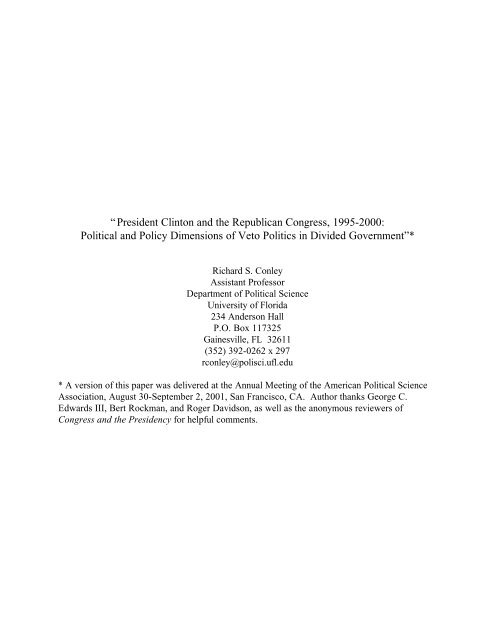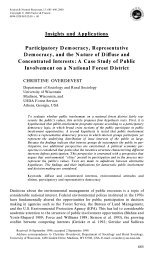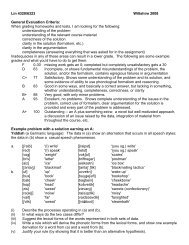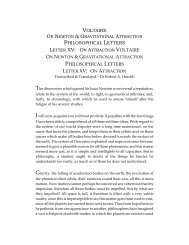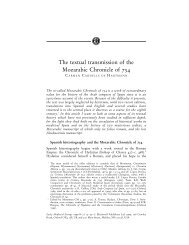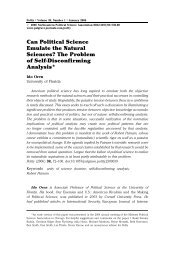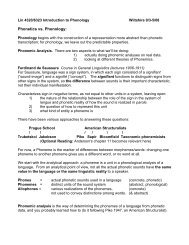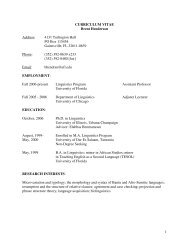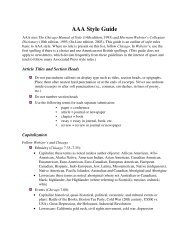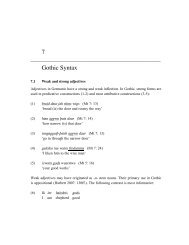âPresident Clinton and the Republican Congress, 1995-2000 ...
âPresident Clinton and the Republican Congress, 1995-2000 ...
âPresident Clinton and the Republican Congress, 1995-2000 ...
You also want an ePaper? Increase the reach of your titles
YUMPU automatically turns print PDFs into web optimized ePapers that Google loves.
“President <strong>Clinton</strong> <strong>and</strong> <strong>the</strong> <strong>Republican</strong> <strong>Congress</strong>, <strong>1995</strong>-<strong>2000</strong>:<br />
Political <strong>and</strong> Policy Dimensions of Veto Politics in Divided Government”*<br />
Richard S. Conley<br />
Assistant Professor<br />
Department of Political Science<br />
University of Florida<br />
234 Anderson Hall<br />
P.O. Box 117325<br />
Gainesville, FL 32611<br />
(352) 392-0262 x 297<br />
rconley@polisci.ufl.edu<br />
* A version of this paper was delivered at <strong>the</strong> Annual Meeting of <strong>the</strong> American Political Science<br />
Association, August 30-September 2, 2001, San Francisco, CA. Author thanks George C.<br />
Edwards III, Bert Rockman, <strong>and</strong> Roger Davidson, as well as <strong>the</strong> anonymous reviewers of<br />
<strong>Congress</strong> <strong>and</strong> <strong>the</strong> Presidency for helpful comments.
“President <strong>Clinton</strong> <strong>and</strong> <strong>the</strong> <strong>Republican</strong> <strong>Congress</strong>, <strong>1995</strong>-<strong>2000</strong>:<br />
Political <strong>and</strong> Policy Dimensions of Veto Politics in Divided Government”<br />
ABSTRACT<br />
This article melds alternative <strong>the</strong>oretical perspectives on veto threats to explain <strong>Clinton</strong>’s<br />
influence over legislative outcomes in <strong>the</strong> 104th-106th <strong>Congress</strong>es (<strong>1995</strong>-<strong>2000</strong>). Formal models<br />
of executive-legislative relations— in particular <strong>the</strong> “coordination model”— yield an incomplete<br />
underst<strong>and</strong>ing of veto politics <strong>and</strong> executive-legislative conflict from <strong>1995</strong>-<strong>2000</strong>. Explaining<br />
<strong>Clinton</strong>’s success through veto politics requires a recognition of <strong>the</strong> unique context of legislative<br />
conflict from <strong>1995</strong>-96. Presidential-congressional relations in <strong>the</strong> 104th <strong>Congress</strong> turned on<br />
“blame-game” politics that <strong>Clinton</strong> manipulated to his advantage. <strong>Clinton</strong>’s second term heralded<br />
a return to “normal politics” during which <strong>the</strong> <strong>Republican</strong> majority’s response to his veto threats<br />
coincided better with <strong>the</strong> basic tenets of <strong>the</strong> coordination model. Quantitative analysis of<br />
<strong>Clinton</strong>’s public threats <strong>and</strong> secondary analysis of bill histories are brought to bear to test <strong>the</strong><br />
<strong>the</strong>oretical framework.
President William Jefferson <strong>Clinton</strong> did not set out to master <strong>Congress</strong> by <strong>the</strong> explicit or<br />
implicit use of <strong>the</strong> veto power. He cast not a single veto in <strong>the</strong> 103 rd <strong>Congress</strong> (1993-94).<br />
However, <strong>the</strong> dramatic return of divided government following <strong>the</strong> elections of 1994, <strong>and</strong><br />
<strong>Republican</strong>s’ continued control of both chambers of <strong>Congress</strong> through <strong>the</strong> end of his second term,<br />
forced <strong>the</strong> president to adapt his legislative presidency to a radically altered political context.<br />
<strong>Clinton</strong> vetoed thirty-five bills (excluding pocket vetoes <strong>and</strong> line-item vetoes) from <strong>1995</strong>-<strong>2000</strong>.<br />
<strong>Republican</strong> leaders challenged eleven of <strong>the</strong> thirty-five vetoes in one or <strong>the</strong> o<strong>the</strong>r chamber but<br />
managed to override <strong>the</strong> president only once. Fur<strong>the</strong>r, <strong>Clinton</strong> relied on <strong>the</strong> implied use of <strong>the</strong><br />
veto— veto threats— on over 140 bills, <strong>and</strong> he was generally successful in halting <strong>the</strong> <strong>Republican</strong>s’<br />
agenda or wresting policy concessions from <strong>the</strong> majority leadership.<br />
<strong>Clinton</strong>’s management of legislative outcomes through <strong>the</strong> veto power raises several<br />
important empirical <strong>and</strong> <strong>the</strong>oretical questions for scholars of <strong>the</strong> legislative presidency. First,<br />
which structural factors enabled <strong>Clinton</strong> to wield <strong>the</strong> veto power with such success, <strong>and</strong> how were<br />
those factors unique from a comparative, historical perspective? Second, how well do extant<br />
formal models of presidential-congressional relations account for <strong>Clinton</strong>’s successful use of <strong>the</strong><br />
veto power <strong>and</strong> legislative outcomes?<br />
This article argues for a more refined conceptualization of presidential success relative to<br />
<strong>the</strong> veto power by incorporating <strong>the</strong> political dimensions of “blame-game” politics (Groseclose<br />
<strong>and</strong> McCarty 2001) between <strong>the</strong> branches. The objective is to demonstrate <strong>Clinton</strong>’s ability to<br />
manipulate “strategic disagreement” (Gilmour <strong>1995</strong>) with <strong>the</strong> GOP majority in <strong>Congress</strong> from<br />
<strong>1995</strong>-96 <strong>and</strong> address <strong>the</strong> implications for formal models of inter-branch bargaining. The<br />
“coordination” model, with a focus on spatial analysis of policy positions between <strong>the</strong> branches,<br />
yields an incomplete underst<strong>and</strong>ing of veto politics <strong>and</strong> executive-legislative conflict from <strong>1995</strong>-<br />
1
<strong>2000</strong>. While Cameron (<strong>2000</strong>) makes <strong>the</strong> case that blame-game politics are anomalous for <strong>the</strong><br />
period he studies, 1 such a contention does not fit <strong>the</strong> context of presidential-congressional<br />
relations in <strong>the</strong> 104th <strong>Congress</strong> particularly well. While nei<strong>the</strong>r <strong>the</strong> GOP congressional majority<br />
nor <strong>Clinton</strong> necessarily set out to engage in high-stakes, blame-game politics, political<br />
considerations— particularly electoral motivations— pushed both sides toward such a strategy<br />
when budget negotiations produced stalemate. The unique context of executive-legislative<br />
conflict from <strong>1995</strong>-96, I argue, laid <strong>the</strong> groundwork for a return to “normal” modes of bargaining<br />
in <strong>Clinton</strong>’s second term which comport better with <strong>the</strong> assumptions of <strong>the</strong> coordination model.<br />
The analysis is organized in four parts. The first section places <strong>Clinton</strong>’s legislative<br />
presidency into comparative context to accentuate how voting coalitions in <strong>Congress</strong> buttressed<br />
<strong>the</strong> foundation for a successful veto strategy. The second section briefly reviews <strong>the</strong> tenets <strong>and</strong><br />
shortcomings of formal models in <strong>the</strong> evaluation of veto threats <strong>and</strong> legislative outcomes, <strong>and</strong><br />
elaborates <strong>the</strong> conditions under which blame-game scenarios between <strong>the</strong> president <strong>and</strong> <strong>the</strong><br />
congressional majority are likely to materialize. The third section presents a twin-pronged<br />
empirical analysis of <strong>Clinton</strong>’s veto threats that melds quantitative <strong>and</strong> qualitative approaches.<br />
Using <strong>the</strong> entire body of <strong>Clinton</strong>’s public veto threats for legislation that passed <strong>and</strong> failed,<br />
legislative outcomes are systematically arrayed along <strong>the</strong> president’s preference continuum under<br />
blame-game <strong>and</strong> coordination model scenarios. Secondary, qualitative analysis of select bill<br />
histories confirms <strong>the</strong> utility of a multiple perspectives approach in modeling veto politics from<br />
<strong>1995</strong>-<strong>2000</strong>. The concluding section offers some final thoughts about veto politics <strong>and</strong> alternative<br />
conceptualizations of presidential success.<br />
CLINTON AND THE REPUBLICAN CONGRESS: VETO THREATS VERSUS<br />
COALITION-BUILDING<br />
2
From a comparative viewpoint, <strong>Clinton</strong>’s strategic position under divided government was<br />
unique in several regards. Party-unity voting <strong>and</strong> a more centralized setting in <strong>Congress</strong> robbed<br />
him of opportunities to forge <strong>the</strong> cross-party coalitions that were frequent in <strong>the</strong> “pre-reform” era<br />
(pre-1973) for <strong>Republican</strong> presidents like Eisenhower <strong>and</strong> even Nixon. In earlier eras moderates<br />
in both parties often held <strong>the</strong> balance of power over legislative outcomes (Bond <strong>and</strong> Fleisher<br />
1990; <strong>2000</strong>). 2 Presidents who faced an opposition majority in <strong>Congress</strong> had more opportunities<br />
to cobble toge<strong>the</strong>r cross-party support for <strong>the</strong>ir policy positions, prevail on floor votes, <strong>and</strong> avoid<br />
extensive reliance on vetoes <strong>and</strong> veto threats. At <strong>the</strong> same time, in an environment of shifting<br />
legislative alliances presidents had to worry about successful overrides of <strong>the</strong>ir vetoes. This<br />
environment provided greater opportunities for presidents to avoid extensive reliance on <strong>the</strong> veto<br />
power.<br />
<strong>Clinton</strong>’s legislative travails are borne out in Figure 1, which shows that cross-party<br />
support reached a nadir in <strong>1995</strong> when <strong>Republican</strong>s supported <strong>the</strong> president’s positions, on<br />
average, only 22 percent of <strong>the</strong> time. Unable to reach across <strong>the</strong> aisle to build winning coalitions,<br />
<strong>Clinton</strong>’s success rate on floor votes from <strong>1995</strong>-<strong>2000</strong> was among <strong>the</strong> lowest for presidents who<br />
have faced divided government in <strong>the</strong> post-War era according to <strong>Congress</strong>ional Quarterly’s<br />
yearly tabulations (<strong>Congress</strong>ional Quarterly Almanacs <strong>1995</strong>-<strong>2000</strong>). <strong>Clinton</strong> opposed over twothirds<br />
of <strong>the</strong> bills that reached <strong>the</strong> floor. Democrats stood firmly behind <strong>Clinton</strong> more than threequarters<br />
of <strong>the</strong> time across his two terms.<br />
[Figure 1]<br />
The central point of Figure is that <strong>the</strong> stability of voting coalitions in <strong>Congress</strong> in <strong>the</strong><br />
104th-106th <strong>Congress</strong>es <strong>and</strong> <strong>the</strong> House <strong>Republican</strong> leadership’s tight grip on floor proceedings<br />
dashed <strong>Clinton</strong>’s hope of any considerable advances of his preferred agenda carrying over from<br />
3
<strong>the</strong> 103rd <strong>Congress</strong>. But strong partisan support did shore up his ability to influence <strong>the</strong> policy<br />
process <strong>and</strong> policy outcomes, ei<strong>the</strong>r by halting <strong>the</strong> GOP agenda with applied vetoes, or redefining<br />
available solutions with implied vetoes— threats— as a means of bringing policy outcomes closer<br />
to his own preferences. <strong>Clinton</strong>’s reactionary <strong>and</strong> sometimes preemptive form of legislative<br />
leadership through veto leverage must be understood as a strategic response to <strong>the</strong> particular<br />
context of divided government that <strong>Clinton</strong> confronted. “Often <strong>the</strong> purpose of a veto threat,”<br />
Sinclair (<strong>2000</strong>, 145) notes, “is not to kill <strong>the</strong> legislation, but to extract concessions from an<br />
opposition majority that has major policy differences with <strong>the</strong> president but lacks <strong>the</strong> strength to<br />
override his vetoes.”<br />
Party-unity gave <strong>Clinton</strong> an advantage in <strong>the</strong> veto power that Harry Truman, <strong>the</strong> only<br />
o<strong>the</strong>r post-War Democratic president to face a <strong>Republican</strong> <strong>Congress</strong>, sorely lacked. Truman, like<br />
<strong>Clinton</strong>, faced a confident <strong>Republican</strong> majority following mid-term elections that reversed partisan<br />
control of <strong>Congress</strong> <strong>and</strong> were widely viewed as discrediting <strong>the</strong> president’s policies. However,<br />
<strong>the</strong> union of <strong>Republican</strong>s <strong>and</strong> sou<strong>the</strong>rn Democrats (<strong>the</strong> conservative coalition) gave <strong>the</strong><br />
congressional majority of <strong>the</strong> 80th <strong>Congress</strong> a veto-proof policy majority that could trump<br />
Truman’s vetoes in a way that was not possible under <strong>Clinton</strong>’s watch because of Democratic<br />
unity (Conley <strong>2000</strong>).<br />
Voting alignments in <strong>Congress</strong> from <strong>1995</strong>-<strong>2000</strong> would have seemingly forced <strong>the</strong><br />
<strong>Republican</strong> majority to take <strong>the</strong> mere threat of a presidential veto seriously. Narrow seat margins<br />
<strong>and</strong> party-unity voting all but assured that challenges to <strong>Clinton</strong>’s vetoes would end in failure.<br />
But we are left with several empirical puzzles. In <strong>the</strong> 104th <strong>Congress</strong> <strong>Republican</strong> leaders often<br />
ignored <strong>Clinton</strong>’s veto threats. Why did <strong>the</strong>y provoke <strong>the</strong> president to veto legislation <strong>and</strong><br />
attempt doomed overrides? Did <strong>the</strong>y believe <strong>Clinton</strong> was bluffing, or were <strong>the</strong>y playing an<br />
4
electoral “blame game” ra<strong>the</strong>r than a legislative “policy” game after budget negotiations failed?<br />
And how did <strong>the</strong> executive-legislative showdown over <strong>the</strong> budget in late <strong>1995</strong> <strong>and</strong> early 1996<br />
persuade <strong>the</strong> <strong>Republican</strong> leadership to take a more judicious response to <strong>Clinton</strong>’s veto threats in<br />
his second term? The next section reviews competing <strong>the</strong>ories about presidential veto threats <strong>and</strong><br />
melds perspectives on “blame-game” <strong>and</strong> “coordination” models of veto threats to underst<strong>and</strong><br />
<strong>Clinton</strong>’s strategy <strong>and</strong> success across his two terms.<br />
MODELING VETOES AND VETO THREATS TO EVALUATE PRESIDENTIAL SUCCESS<br />
Scholars have posited two competing frameworks to account for veto threats’ force of<br />
influence: <strong>the</strong> “commitment” <strong>and</strong> “coordination” models. The commitment model suggests that<br />
<strong>the</strong> effectiveness of veto threats turns on <strong>the</strong> president’s public pledges. “The effect of political<br />
rhetoric,” Charles Cameron (<strong>2000</strong>, 196) posits, “is to constrain <strong>the</strong> speaker so he can’t retreat<br />
from his position without paying a steep price.” Reneging on a promise might entail electoral<br />
retaliation, sully <strong>the</strong> president’s reputation in <strong>Congress</strong>, or cost him in <strong>the</strong> court of public opinion.<br />
George Bush’s 1990 volte-face on his “read my lips, no new taxes” promise of <strong>the</strong> 1988<br />
campaign, <strong>and</strong> conservatives’ ire in <strong>Congress</strong> <strong>and</strong> in <strong>the</strong> electorate, places into sharp relief <strong>the</strong><br />
dangers of backtracking on a public veto commitment (see Eastl<strong>and</strong> 1992).<br />
Ingberman <strong>and</strong> Yao (1991) contend that going public with a commitment to veto<br />
legislation also gives presidents some level of proposal power by indicating to <strong>Congress</strong> which<br />
provisions a bill must or must not contain to earn his approval. Bill <strong>Clinton</strong> utilized just such a<br />
type of threat on his health care reform proposal during his 1994 State of <strong>the</strong> Union Address by<br />
pledging to veto any bill that did not guarantee universal coverage (Weekly Compilation of<br />
Presidential Documents, 1/25/94, 153). Presidents may also turn to a bluffing strategy <strong>and</strong><br />
5
threaten to veto bills <strong>the</strong>y might o<strong>the</strong>rwise accept to gain a strategic edge over <strong>Congress</strong> <strong>and</strong> bring<br />
outcomes closer to <strong>the</strong>ir preferences (see McCarty 1997).<br />
Despite appealing intuitive elements, <strong>the</strong> commitment model suffers from several empirical<br />
difficulties. The formal model forecasts that presidents will make good on <strong>the</strong>ir veto threat unless<br />
<strong>Congress</strong> yields completely to <strong>the</strong>ir dem<strong>and</strong>s. However, more than half of <strong>the</strong> threatened bills that<br />
passed according to Cameron’s (<strong>2000</strong>) cataloguing of public threats were not vetoed when<br />
<strong>Congress</strong> failed to comply fully. Clearly, presidents do not veto all legislation when <strong>Congress</strong><br />
concedes to some, but not all, of <strong>the</strong>ir stipulations. The model also predicts that <strong>Congress</strong> will<br />
successfully override <strong>the</strong> president’s veto, but <strong>Congress</strong> actually fails to do so fourth-fifths of <strong>the</strong><br />
time (Cameron <strong>2000</strong>, 197).<br />
The Coordination Model<br />
The coordination model is an alternative approach for underst<strong>and</strong>ing <strong>the</strong> impact of public<br />
veto threats on inter-branch bargaining. The spatial model assumes that <strong>the</strong> president <strong>and</strong><br />
<strong>Congress</strong> are interested in substantive policy outcomes. The model was developed by Mat<strong>the</strong>ws<br />
(1989) with <strong>the</strong> central premise that <strong>Congress</strong> has incomplete information on which bills <strong>the</strong><br />
president may prefer to <strong>the</strong> status quo. Cameron (<strong>2000</strong>, 181-82) emphasizes that “if <strong>the</strong><br />
president’s veto threat is to have any effect on <strong>the</strong> legislature, <strong>Congress</strong> must be somewhat unsure<br />
about what policies <strong>the</strong> president will accept.” The supposition is that <strong>Congress</strong> does not know<br />
whe<strong>the</strong>r <strong>the</strong> president is an accommodator, who will accept <strong>the</strong> majority’s ideal point, or whe<strong>the</strong>r<br />
he is a compromiser with whom <strong>the</strong> majority must negotiate. If <strong>Congress</strong> knows that <strong>the</strong><br />
president will ultimately accept <strong>the</strong> policies it passes, veto threats have no basis for influence <strong>and</strong><br />
are simply “cheap talk.”<br />
6
If, however, <strong>Congress</strong> is uncertain about what <strong>the</strong> president will accept, legislators will<br />
meet <strong>the</strong> president’s dem<strong>and</strong>s as far as <strong>the</strong>y deem necessary to circumvent a veto. The key to <strong>the</strong><br />
power of <strong>the</strong> president’s veto is his “policy reputation” in <strong>Congress</strong>, which bolsters <strong>the</strong> sincerity<br />
of <strong>the</strong> threat. Mat<strong>the</strong>ws <strong>and</strong> Cameron argue that <strong>the</strong> president’s rhetoric gives legislators an<br />
estimation of his position as an accommodator or a compromiser. In o<strong>the</strong>r words <strong>the</strong> president’s<br />
public statements indicate to members of <strong>Congress</strong> how extensively <strong>the</strong>y must revise legislation to<br />
meet his approval. The president may choose to object publicly to many more legislative<br />
provisions than he actually opposes in order to maximize potential concessions. Alternatively, he<br />
may emphatically object to only select language in bills, as <strong>Clinton</strong> did repeatedly on abortion<br />
issues from <strong>1995</strong>-<strong>2000</strong>. The idea is that <strong>the</strong> president’s rhetoric signals important, if imperfect,<br />
information to legislative leaders, who will in turn offer <strong>the</strong> most favorable compromise to<br />
accommodate <strong>the</strong> president’s dem<strong>and</strong>s <strong>and</strong> get priority legislation passed.<br />
The advantage of <strong>the</strong> coordination model, as Cameron (<strong>2000</strong>) shows, is that it explains<br />
executive-legislative compromise better than <strong>the</strong> commitment model. The model provides a basis<br />
for underst<strong>and</strong>ing why presidents are typically not compelled to actually apply vetoes to<br />
threatened legislation. In addition, a structure of stable voting coalitions works in t<strong>and</strong>em with<br />
<strong>the</strong> assumptions of <strong>the</strong> coordination model in terms of <strong>the</strong> president’s policy reputation. Intraparty<br />
cohesion <strong>and</strong> narrow party-margins in <strong>Congress</strong> bolster <strong>the</strong> president’s ability to make good<br />
on veto threats if <strong>Congress</strong> does not comply at least partially with his dem<strong>and</strong>s since override<br />
attempts will most likely be thwarted. Finally, <strong>the</strong> model also explains why some veto threats<br />
appear ineffectual. Because presidents’ public threats naturally convey <strong>the</strong>ir preferences with<br />
some ambiguity, sometimes legislative leaders underestimate <strong>the</strong> president’s minimal acceptance<br />
point <strong>and</strong> unintentionally provoke a veto.<br />
7
Shortcomings of <strong>the</strong> Coordination Model: Electoral Motivations <strong>and</strong> Blame-Game Politics<br />
It is never<strong>the</strong>less possible that <strong>the</strong> congressional majority intentionally sets out to trigger a<br />
presidential veto <strong>and</strong>/or attempts an abortive override vote to call attention to inter-branch<br />
conflict. Similarly, <strong>the</strong> president may purposefully veto legislation to build a case in <strong>the</strong> public<br />
arena against <strong>the</strong> congressional majority under divided government. With a focus on substantive<br />
aspects of legislation <strong>and</strong> presidential-congressional negotiation, <strong>the</strong> coordination model<br />
encounters some difficulty with such “blame-game” scenarios.<br />
From <strong>the</strong> congressional st<strong>and</strong>point, <strong>the</strong> majority’s denial of <strong>the</strong> president’s objections as<br />
articulated through a veto threat is nei<strong>the</strong>r a misreading of his policy position nor a loss of<br />
credibility in his policy reputation. Ra<strong>the</strong>r, in this “position-taking game” <strong>the</strong> congressional<br />
majority perceives some electoral or constituency benefits inhering in ei<strong>the</strong>r provoking a veto<br />
<strong>and</strong>/or attempting an override that outweighs <strong>the</strong> potential cost of a probable loss (Conley <strong>and</strong><br />
Kreppel 2001). Under structural conditions similar to those of <strong>the</strong> 104th-106th <strong>Congress</strong>es an<br />
examination of passage coalitions on legislation would inform majority leaders that an override<br />
following a vote along strict party lines would, in all likelihood, fail. Yet <strong>the</strong>y risk <strong>the</strong> override<br />
anyway because <strong>the</strong>ir goal is not to change <strong>the</strong> legislative outcome, but to blame <strong>the</strong> president for<br />
obstruction of <strong>the</strong>ir agenda, garner public sympathy, <strong>and</strong> posture for <strong>the</strong> next round of interbranch<br />
negotiations— or <strong>the</strong> next election. The veto override attempt in this context becomes <strong>the</strong><br />
pivot point for in <strong>the</strong> blame-game.<br />
The president may also engage in <strong>the</strong> blame-game <strong>and</strong> veto legislation to make a larger<br />
point in <strong>the</strong> public eye. Presidents Ford <strong>and</strong> Reagan, for example, vetoed budget legislation with<br />
bipartisan support to chastise <strong>Congress</strong> for its spending habits, <strong>and</strong> <strong>the</strong>y faced successful<br />
overrides. <strong>Clinton</strong>, as will be shown, vetoed what is typically <strong>the</strong> least controversial of<br />
8
appropriations bills— legislative appropriations— to gain leverage over <strong>Republican</strong>s in <strong>the</strong> 104th<br />
<strong>Congress</strong>. In <strong>the</strong>se cases it is clear that o<strong>the</strong>r presidential motivations trumped policy<br />
considerations. Blocking legislation or having <strong>the</strong>ir vetoes overridden enabled presidents to<br />
“have” <strong>the</strong> issue <strong>and</strong> build a case against <strong>Congress</strong>.<br />
Blame-game politics surrounding vetoes <strong>and</strong> veto threats may be understood as an<br />
extreme form of “going public” (Kernell 1997) <strong>and</strong> are quite important for setting <strong>the</strong> tone for<br />
executive-legislative bargaining during <strong>Clinton</strong>’s second term. The special nature of spending bills<br />
gave <strong>the</strong> <strong>Republican</strong> majority in <strong>the</strong> 104th <strong>Congress</strong> <strong>and</strong> <strong>the</strong> president a particular incentive to<br />
pursue what Gilmour (<strong>1995</strong>) calls “strategic disagreement.” Unlike discretionary domestic<br />
policies, appropriations bills comprise a “must-pass” category to keep <strong>the</strong> federal government in<br />
operation. And constitutionally, spending bills must originate in <strong>the</strong> House of Representatives,<br />
where congressional leaders are far more able to control legislative outcomes with restrictive rules<br />
compared to <strong>the</strong>ir Senate counterparts.<br />
In <strong>the</strong> 104th <strong>Congress</strong> GOP leaders attempted to use appropriations bills as leverage<br />
against <strong>Clinton</strong> for <strong>the</strong> adoption of <strong>the</strong>ir agenda— much of which was eventually contained in <strong>the</strong><br />
budget reconciliation bill. Refusing to modify legislation in <strong>the</strong> face of <strong>Clinton</strong>’s veto threats, <strong>the</strong>y<br />
provoked vetoes <strong>and</strong> selectively attempted overrides <strong>the</strong>y knew had no chance of success based<br />
on <strong>the</strong> structure of <strong>the</strong> bills’ original passage coalition. They hoped to call <strong>the</strong> president’s bluff by<br />
forcing a government shutdown <strong>and</strong> forging a public backlash against him after negotiations<br />
failed.<br />
While it may be argued that <strong>the</strong> GOP leadership was playing a “multiple bill” game— that<br />
is, holding hostage a host of appropriations bills early in <strong>the</strong> 104th <strong>Congress</strong> to gain influence over<br />
provisions in <strong>the</strong> reconciliation legislation— <strong>the</strong> fact remains that <strong>the</strong> <strong>Republican</strong> majority<br />
9
continued to provoke vetoes <strong>and</strong> attempted doomed overrides well after <strong>Clinton</strong> refused to budge<br />
on <strong>the</strong>ir fiscal priorities <strong>and</strong> had vetoed <strong>the</strong> reconciliation legislation. Moreover, <strong>the</strong> <strong>Republican</strong><br />
leadership pursued overrides on non-budgetary bills vetoed by <strong>Clinton</strong>, such as abortion<br />
legislation, to posture for <strong>the</strong> 1996 elections. At this juncture spatial analysis does not explain <strong>the</strong><br />
GOP’s strategy. The “multiple bill” hypo<strong>the</strong>sis forms only part of <strong>the</strong> overall context. Across<br />
substantive issues <strong>the</strong> legislative or “policy game” was trumped by <strong>the</strong> political dimensions of <strong>the</strong><br />
blame-game as <strong>Clinton</strong> <strong>and</strong> <strong>the</strong> GOP faced <strong>the</strong> 1996 elections in less than eleven months.<br />
Electoral motivations pushed <strong>the</strong> <strong>Republican</strong>s to attempt to build a public case against <strong>Clinton</strong> <strong>and</strong><br />
blame him for policy stalemate.<br />
The centrality of blame game politics in <strong>Clinton</strong>’s early experience under divided<br />
government emphasizes <strong>the</strong> importance of a multifaceted approach in <strong>the</strong> evaluation of<br />
presidential “success” on veto threats. In <strong>the</strong> coordination game, presidents attempt to get <strong>the</strong><br />
majority to capitulate to <strong>the</strong>ir policy dem<strong>and</strong>s, or at a minimum, gain some level of compromise—<br />
<strong>and</strong> <strong>the</strong> congressional majority would ra<strong>the</strong>r choose concessions over no legislation.<br />
Alternatively, in <strong>the</strong> blame-game scenario <strong>the</strong> politics of brinksmanship may supplant “normal”<br />
preferences for policy compromise. The congressional majority may provoke vetoes <strong>and</strong>/or<br />
attempt overrides in <strong>the</strong> bid to embarrass <strong>the</strong> president in <strong>the</strong> public arena. The president may<br />
also prefer to veto legislation to build a case against <strong>the</strong> majority. What becomes paramount is<br />
each player’s relative confidence in winning <strong>the</strong> public relations duel.<br />
Underst<strong>and</strong>ing <strong>Clinton</strong>’s Strategy: A Multi-Stage Approach<br />
<strong>Clinton</strong>’s veto threat strategy is best understood by approaching executive-legislative<br />
relations through <strong>the</strong> lens of <strong>the</strong> “blame-game” in <strong>the</strong> 104th <strong>Congress</strong> <strong>and</strong> <strong>the</strong> legislative<br />
“coordination game” in <strong>the</strong> 105th-106th <strong>Congress</strong>es. The models can be tested with empirical<br />
10
data by evaluating legislative outcomes <strong>and</strong> arraying <strong>the</strong> president’s hypo<strong>the</strong>tical outcome<br />
preferences in each scenario.<br />
[Figure 2]<br />
Figure 2 presents a decision-tree on potential legislative outcomes following a veto threat.<br />
Of course, <strong>the</strong>se preference orderings are not absolutes. The decision tree is a heuristic. The<br />
preference continuums are meant to cast light on <strong>the</strong> relative success of veto threats under<br />
different assumptions about <strong>the</strong> type of game in which <strong>the</strong> congressional majority <strong>and</strong> <strong>the</strong><br />
president was engaged.<br />
In <strong>the</strong> legislative or “policy” game, according to <strong>the</strong> coordination model, <strong>the</strong> order of <strong>the</strong><br />
president’s preferences may be expressed as follows: P0>P1?P2?C4>C6>C8=C10>P4>C9>C11.<br />
The primary objective of <strong>the</strong> president’s veto threat is to get <strong>Congress</strong> to capitulate, kill <strong>the</strong> bill, 3<br />
or obtain substantial policy concessions. Clearly, <strong>the</strong> president would prefer that <strong>the</strong> majority<br />
acquiesce entirely to his dem<strong>and</strong>s (P0). Having <strong>the</strong> bill tabled in committee, killed by a floor vote,<br />
or passed in one chamber but never taken up in <strong>the</strong> o<strong>the</strong>r chamber (P1) is potentially equivalent to<br />
a compromise (P2), depending on <strong>the</strong> scope of <strong>the</strong> concessions <strong>the</strong> president must make in such a<br />
compromise. At <strong>the</strong> same time, lthough <strong>the</strong> president may be successful in halting <strong>the</strong> bill based<br />
on his particular objections, provisions he might o<strong>the</strong>rwise support also do not pass.<br />
In such a “legislative game,” congressional capitulation, failure of <strong>the</strong> bill, or inter-branch<br />
compromise following a veto threat are all favorable to casting a veto with <strong>the</strong> risk that it might<br />
be challenged. However, failed override attempts following compromise that does not go far<br />
enough to satisfy <strong>the</strong> president’s dem<strong>and</strong>s (C4) or <strong>the</strong> majority’s outright denial of <strong>the</strong> president’s<br />
objections (C8) are none<strong>the</strong>less preferable to accepting <strong>the</strong> bill (P4). Obviously, any successful<br />
11
override following a compromise shunned by <strong>the</strong> president (C9) or <strong>the</strong> majority’s decision to<br />
reject any recognition of <strong>the</strong> president’s concerns (C11) is <strong>the</strong> least preferable outcome.<br />
The president’s preference order may take quite a different shape if he recognizes that <strong>the</strong><br />
congressional majority is playing a different game— or chooses to engage in <strong>the</strong> blame-game<br />
himself. In Figure 2 <strong>the</strong> blame-game path is represented by <strong>the</strong> upper portion of <strong>the</strong> diagram,<br />
beginning with C3, or <strong>the</strong> majority’s decision to deny <strong>the</strong> president’s objections in <strong>the</strong> bill. Under<br />
this scenario in which <strong>the</strong> congressional majority’s interest is in building public or electoral<br />
support, <strong>the</strong> president’s preference order may be expressed as follows:<br />
C10?C6>C8?C4>P0>P1>P2>P4>C9=C11. Vetoes <strong>and</strong>/or failed override attempts that bring<br />
inter-branch policy disputes into <strong>the</strong> media spotlight may, in fact, be favorable to unchallenged<br />
vetoes, congressional capitulation, or compromise.<br />
Under circumstances of intense partisan disagreement, <strong>the</strong> blame-game can enhance <strong>the</strong><br />
president’s policy reputation <strong>and</strong> negotiating position. A skillful president can use <strong>the</strong> power of<br />
<strong>the</strong> bully pulpit <strong>and</strong> his veto message to lay out for <strong>the</strong> public his rationale for returning legislation<br />
to <strong>Congress</strong> <strong>and</strong> portray himself as a conciliator. When <strong>the</strong> congressional majority triggers a veto<br />
or attempts an override to marshal public sympathy <strong>and</strong> build electoral support (or <strong>the</strong> president<br />
vetoes legislation to make a public case) <strong>the</strong> burden shifts to leaders on Capitol Hill who must<br />
explain <strong>the</strong>ir logic for denying <strong>the</strong> president’s objections. There is some evidence that public<br />
esteem for <strong>Congress</strong> falls when leaders challenge <strong>the</strong> president (Durr, Gilmour, <strong>and</strong> Wolbrecht<br />
1997). They may find <strong>the</strong>mselves at a relative disadvantage to <strong>the</strong> president because <strong>the</strong>y do not<br />
comm<strong>and</strong> <strong>the</strong> same level of media attention or resources to make <strong>the</strong>ir case to <strong>the</strong> public.<br />
A failed override on legislation for which <strong>the</strong> majority has ei<strong>the</strong>r denied <strong>the</strong> president’s<br />
objections or compromised too little <strong>and</strong> provoked a veto can vindicate <strong>the</strong> president’s policy<br />
12
position in <strong>the</strong> public arena. Failed blame-game override attempts can also shore up <strong>the</strong><br />
president’s partisan base in <strong>Congress</strong> <strong>and</strong> in <strong>the</strong> electorate. If <strong>the</strong> majority’s strategy backfires, as<br />
it did in <strong>1995</strong>/96 on appropriations bills, <strong>the</strong> president may win not only in <strong>the</strong> court of public<br />
opinion <strong>and</strong> streng<strong>the</strong>n his strategic position on <strong>the</strong> next round of negotiations but also convince<br />
opposition majority leaders of <strong>the</strong> need to obviate blame-game tactics <strong>and</strong> reach compromise<br />
following future veto threats.<br />
DATA AND ANALYSIS<br />
Public veto threats issued by <strong>Clinton</strong> during <strong>the</strong> 104th-106th <strong>Congress</strong>es were catalogued<br />
using <strong>the</strong> searchable, on-line archives of <strong>Congress</strong>ional Quarterly Weekly Reports. This search<br />
yielded a total of 143 veto threats from <strong>1995</strong>-<strong>2000</strong>: Forty-one for <strong>the</strong> 104th <strong>Congress</strong>, forty-six<br />
for <strong>the</strong> 105th <strong>Congress</strong>, <strong>and</strong> fifty-six for <strong>the</strong> 106th <strong>Congress</strong>. For bills that passed or were subject<br />
to vetoes, <strong>the</strong> provisions to which <strong>Clinton</strong> objected were ascertained using <strong>Congress</strong>ional<br />
Quarterly, Washington Post, <strong>and</strong> New York Times reports on bill histories, <strong>and</strong> compared against<br />
provisions contained in <strong>the</strong> final legislation. This methodology yields an overall assessment of<br />
legislative outcomes <strong>and</strong> facilitates arraying <strong>the</strong> president’s set of preference outcomes under<br />
blame-game <strong>and</strong> coordination model assumptions.<br />
Qualitative analysis of bill histories enables us to better grasp <strong>the</strong> intricate dynamics of<br />
strategic disagreement <strong>and</strong> policy compromise. As Deen <strong>and</strong> Arnold (2002) demonstrate in <strong>the</strong>ir<br />
analysis of veto threats in <strong>the</strong> George H.W. Bush administration, case studies are highly useful in<br />
assessing <strong>the</strong> extent of policy compromise <strong>and</strong> conflict between <strong>the</strong> branches. Veto threats do not<br />
occur in a vacuum— <strong>the</strong>ir force of influence must be understood within <strong>the</strong> political context<br />
surrounding executive-legislative relations. Examining <strong>the</strong> legislative histories of threatened<br />
legislation conveys better <strong>the</strong> types of threat signals <strong>the</strong> president sent <strong>and</strong> <strong>the</strong> congressional<br />
13
eaction. Moreover, a closer analysis of presidential-congressional interaction on threatened<br />
legislation qualifies <strong>the</strong> classification of threats along <strong>the</strong> outcome continuum <strong>and</strong> furnishes a<br />
means to test <strong>the</strong> blame-game hypo<strong>the</strong>sis in <strong>the</strong> 104th <strong>Congress</strong>.<br />
Veto Threats <strong>and</strong> Legislative Outcomes Under Competing Assumptions<br />
Table 1 presents legislative outcomes across <strong>the</strong> three periods in cross-tabular format.<br />
The arrangement of outcomes follows straightforwardly <strong>the</strong> paths in Figure 2: <strong>Congress</strong>ional<br />
yielding to <strong>the</strong> president’s objections (C1), inter-branch compromise (C2), or congressional denial<br />
of <strong>the</strong> president’s objections (C3).<br />
[Table 1]<br />
These data underscore how <strong>the</strong> GOP majority <strong>and</strong> <strong>Clinton</strong> appeared to be engaged in<br />
different types of games from <strong>1995</strong>-96 <strong>and</strong> from 1997-<strong>2000</strong>. While <strong>Congress</strong> rarely capitulated<br />
fully to <strong>the</strong> president’s objections, veto threats often resulted in <strong>the</strong> failure of bills (P1)— but more<br />
frequently after 1996. The failure of bills increased significantly from <strong>the</strong> 104th <strong>Congress</strong> (36.6%)<br />
to almost half in <strong>the</strong> 105th <strong>Congress</strong> <strong>and</strong> remained above 40% for <strong>the</strong> 106th <strong>Congress</strong>. In <strong>the</strong>se<br />
cases <strong>the</strong> bills failed in committee or on <strong>the</strong> floor, or were passed by one chamber <strong>and</strong> never taken<br />
up in <strong>the</strong> o<strong>the</strong>r. The increased inability of <strong>the</strong> majority to present enrolled bills to <strong>the</strong> president<br />
appears in part due to a declining willingness to challenge <strong>Clinton</strong>’s veto threats.<br />
This assertion is born out by examining <strong>the</strong> blame-game (deny) path in Table 1. The GOP<br />
majority ignored <strong>Clinton</strong>’s objections on a quarter of all threatened legislation in <strong>the</strong> 104th<br />
<strong>Congress</strong> <strong>and</strong> provoked ten vetoes (C6, C10). Moreover, <strong>the</strong> <strong>Republican</strong> majority brought five of<br />
<strong>the</strong> ten vetoed bills up for overrides that failed (C10). What is similarly telling is that <strong>the</strong><br />
percentage of threatened bills that yielded compromise <strong>and</strong> were accepted by <strong>the</strong> president (P2)<br />
doubled from <strong>the</strong> 104th to <strong>the</strong> 105th <strong>Congress</strong>es. Finally, after 1996 <strong>the</strong> GOP majority was<br />
14
largely disinclined to challenge <strong>Clinton</strong>’s vetoes when <strong>the</strong> leadership denied his legislative<br />
objections. The <strong>Republican</strong> majority challenged <strong>the</strong> president’s veto only once in <strong>the</strong> 105th/106th<br />
<strong>Congress</strong>es. These data suggest <strong>the</strong> degree to which inter-branch bargaining dynamics<br />
substantively changed across <strong>the</strong> three congressional periods.<br />
[Figures 3 <strong>and</strong> 4]<br />
These same data may be arrayed according to <strong>the</strong> president’s hypo<strong>the</strong>tical preference<br />
outcomes under blame-game <strong>and</strong> coordination model assumptions. Figure 3 suggests that if<br />
<strong>Clinton</strong> recognized <strong>and</strong> engaged <strong>the</strong> majority’s blame-game politics in <strong>the</strong> 104th <strong>Congress</strong>, <strong>the</strong><br />
vetoes cast after denials of his objections <strong>and</strong> <strong>the</strong> failed override attempts could work to his<br />
advantage. By contrast, Figure 4 suggests that under coordination model assumptions <strong>Clinton</strong><br />
could boast his ability to halt objectionable legislation (P1). And on compromise legislation, he<br />
was most successful in thwarting <strong>Republican</strong> “policy riders” with which he disagreed on<br />
appropriations <strong>and</strong> o<strong>the</strong>r substantive bills. The more frequent compromises struck on legislation<br />
passed from 1997-<strong>2000</strong> (P2) gave both <strong>Clinton</strong> <strong>and</strong> <strong>the</strong> GOP majority a basis for credit-claiming.<br />
How did <strong>Clinton</strong> successfully manage strategic disagreement in <strong>the</strong> 104th <strong>Congress</strong>, <strong>and</strong><br />
how did those dynamics shape executive-legislative relations through <strong>the</strong> veto power after his<br />
reelection in 1996? The next sub-section examines more closely <strong>the</strong> risky politics of <strong>the</strong> public<br />
blame-game in <strong>the</strong> 104th <strong>Congress</strong> <strong>and</strong> <strong>the</strong> longer-term consequences for presidentialcongressional<br />
relations in <strong>Clinton</strong>’s second term.<br />
Round One: Veto Threats in <strong>the</strong> 104th <strong>Congress</strong> <strong>and</strong> <strong>the</strong> Politics of Public Posturing<br />
The federal budget dominated presidential-congressional attention from <strong>1995</strong>-96 <strong>and</strong> <strong>the</strong><br />
GOP’s Contract with America became <strong>the</strong> focal point of inter-branch conflict. The congressional<br />
majority sought to curb governmental spending, cut or eliminate a host of domestic <strong>and</strong> foreign<br />
15
programs, <strong>and</strong> reduce regulatory burdens on <strong>the</strong> private sector. In <strong>the</strong> public contest between <strong>the</strong><br />
branches <strong>Clinton</strong> deftly outmaneuvered <strong>the</strong> majority, making good on his veto pledges <strong>and</strong> staging<br />
a coordinated effort with congressional Democrats to variably beat back <strong>and</strong> moderate <strong>the</strong> GOP<br />
agenda.<br />
Budget issues pitted <strong>the</strong> White House <strong>and</strong> <strong>the</strong> <strong>Republican</strong>s on Capitol Hill against one<br />
ano<strong>the</strong>r in an acute public relations battle. To return to Figure 3 momentarily, in <strong>the</strong> relatively<br />
rare cases in which inter-branch compromise emerged (P2) or <strong>the</strong> majority capitulated to <strong>the</strong><br />
president’s objections (P0), it was typically on spending issues with less symbolism attached to<br />
<strong>the</strong>m <strong>and</strong> o<strong>the</strong>r minor elements of <strong>the</strong> GOP agenda. 4<br />
Only once was <strong>the</strong> <strong>Republican</strong>-led <strong>Congress</strong><br />
able to override <strong>Clinton</strong>’s veto in six years (C9). The successful override on <strong>the</strong> issue of<br />
shareholder lawsuits turned out to be quite atypical, as <strong>Clinton</strong> vetoed <strong>the</strong> bipartisan bill on<br />
technical issues that Democrats believed <strong>the</strong>y had resolved to <strong>the</strong> president’s satisfaction. 5<br />
Much more common was <strong>the</strong> inter-branch blame game on spending issues. Five of <strong>the</strong><br />
eleven bills <strong>Clinton</strong> sent back to <strong>Congress</strong> contained “veto bait” provisions (C6). Ra<strong>the</strong>r than<br />
yield to <strong>the</strong> president’s objections, <strong>the</strong> GOP majority was content to st<strong>and</strong> firm on policy positions<br />
<strong>and</strong> use <strong>the</strong> high-profile vetoes as defining issues for <strong>the</strong> upcoming 1996 elections. On ano<strong>the</strong>r<br />
five bills, <strong>and</strong> as part of <strong>the</strong>ir effort to blame <strong>the</strong> White House for gridlock, <strong>Republican</strong> leaders<br />
attempted overrides that were doomed to fail because <strong>the</strong> legislation had originally passed along<br />
near-party line votes in <strong>the</strong> House (C10). These provoked vetoes <strong>and</strong> ill-fated override attempts<br />
were aimed at embarrassing <strong>the</strong> president <strong>and</strong> casting blame for <strong>the</strong> government shutdown on <strong>the</strong><br />
White House. But when <strong>Republican</strong>s threw down <strong>the</strong> gauntlet, <strong>Clinton</strong> <strong>and</strong> <strong>the</strong> Democratic<br />
minority in <strong>Congress</strong> stood ready to joust in <strong>the</strong> court of public opinion.<br />
16
As early as late Spring <strong>1995</strong>, when authorizing <strong>and</strong> appropriations committees in <strong>Congress</strong><br />
started work on spending bills, <strong>Clinton</strong> began issuing veto threats to sway GOP leaders to drop<br />
objectionable provisions, retain certain programs, or restore funding to o<strong>the</strong>rs. As battles<br />
between <strong>the</strong> president <strong>and</strong> <strong>Congress</strong> over budgetary <strong>and</strong> programmatic priorities loomed, House<br />
leaders demonstrated an unwavering commitment to <strong>the</strong> objectives outlined in <strong>the</strong> Contract with<br />
America. <strong>Clinton</strong>’s implicit, early message to <strong>Republican</strong>s seemed to be “go ahead, make my<br />
day” <strong>and</strong> defy me to wield <strong>the</strong> veto (Schneider <strong>1995</strong>). He used <strong>the</strong> threat of vetoes <strong>and</strong> worked in<br />
t<strong>and</strong>em with congressional Democrats’ opposition to <strong>the</strong> Contract to portray <strong>the</strong> majority’s<br />
domestic program cuts as “extreme” in <strong>the</strong> public eye. The GOP majority came to underst<strong>and</strong> too<br />
late how <strong>the</strong> structure of internal politics in <strong>Congress</strong> played to <strong>Clinton</strong>’s h<strong>and</strong>: “<strong>Clinton</strong> had little<br />
incentive to sign onto <strong>the</strong>ir agenda <strong>and</strong> <strong>the</strong>y did not have <strong>the</strong> votes to override his veto. In <strong>the</strong><br />
end, <strong>Republican</strong>s were unable to reconcile sentiment in <strong>the</strong>ir conference that abhors compromise,<br />
with <strong>the</strong> need to attain compromise with <strong>the</strong> White House to enact <strong>the</strong> GOP agenda” (Cloud <strong>and</strong><br />
Koszczuk <strong>1995</strong>).<br />
The harbinger of public confrontation between <strong>Clinton</strong> <strong>and</strong> Speaker Gingrich that would<br />
shut down portions of <strong>the</strong> executive branch in late <strong>1995</strong> <strong>and</strong> early 1996 came only six months into<br />
<strong>the</strong> 104th <strong>Congress</strong>. In June <strong>1995</strong> <strong>Republican</strong>s crafted a supplemental appropriations/recissions<br />
bill (HR 1158). The GOP majority set a trap for <strong>the</strong> president. Part of <strong>the</strong> bill provided financial<br />
assistance to flood-stricken states <strong>and</strong> earthquake-damaged California. But House leaders used<br />
<strong>the</strong> recissions portion of <strong>the</strong> bill to take direct aim at some of <strong>Clinton</strong>’s most cherished domestic<br />
programs <strong>and</strong> legislative accomplishments during his first two years in office, including national<br />
service (Americorps) <strong>and</strong> Goals <strong>2000</strong> (education) (Taylor <strong>1995</strong>). <strong>Republican</strong>s as well as<br />
Democrats believed a veto of <strong>the</strong> disaster relief bill, which also contained aid for Oklahoma City<br />
17
subsequent to <strong>the</strong> bombing of <strong>the</strong> Mura Federal Building, could prove “dicey,” as Democratic<br />
Senator Dale Bumpers put it (Healey <strong>1995</strong>). <strong>Clinton</strong> successfully won back some $835 million in<br />
rescinded funds in <strong>the</strong> Senate version of <strong>the</strong> bill, but House-Senate conferees ignored <strong>the</strong><br />
compromise <strong>and</strong> pushed forth with a $16.4 billion package of cuts that <strong>the</strong> administration called<br />
unacceptable (Morgan <strong>and</strong> Devroy <strong>1995</strong>).<br />
HR 1158 marked <strong>Clinton</strong>’s first attempt to re-frame <strong>the</strong> public debate over <strong>the</strong> GOP<br />
agenda through <strong>the</strong> veto power. To some observers, <strong>the</strong> president’s threat to nix <strong>the</strong> bill appeared<br />
contrived. <strong>Clinton</strong> accused <strong>the</strong> majority of forsaking critical domestic programs in favor of pet<br />
constituency projects, even though he had favored some of those very projects in <strong>the</strong> past<br />
(Schneider <strong>1995</strong>). He forcefully opposed <strong>the</strong> measure <strong>and</strong> publicly criticized GOP leaders,<br />
forewarning that “I believe a bill that cuts education to put in pork is <strong>the</strong> wrong way to balance<br />
<strong>the</strong> budget, <strong>and</strong> I will veto it” (Devroy <strong>and</strong> Morgan <strong>1995</strong>). While Speaker Gingrich <strong>and</strong> <strong>the</strong><br />
<strong>Republican</strong>s tried to convince <strong>the</strong> nation <strong>the</strong>y were making good on <strong>the</strong>ir electoral promise of<br />
smaller government, <strong>Clinton</strong> <strong>and</strong> Democrats endeavored to use <strong>the</strong> supplemental appropriations<br />
legislation as an exemplar for o<strong>the</strong>r bills <strong>the</strong>y hoped to denounce as fiscally “reckless” or socially<br />
“irresponsible.”<br />
The dynamics of <strong>Clinton</strong>’s eventual veto of HR 1158— <strong>the</strong> first veto of his presidency—<br />
reflected a basic pattern for o<strong>the</strong>r vetoed budgetary legislation in a number of ways. First, <strong>Clinton</strong><br />
bolstered his policy reputation in <strong>Congress</strong> by carrying through on <strong>the</strong> veto threat when <strong>the</strong><br />
majority called his bluff. The veto of HR 1158 settled <strong>the</strong> question of <strong>the</strong> president’s “relevance”<br />
in <strong>the</strong> legislative process vis-à-vis <strong>the</strong> GOP agenda (Mitchell <strong>1995</strong>). And he proved he could<br />
“make it stick by comm<strong>and</strong>ing enough votes not to be overridden by <strong>Congress</strong>” (Cloud <strong>1995</strong>).<br />
<strong>Republican</strong>s faced an overwhelming deficit of votes for a successful override. Second, <strong>the</strong> GOP<br />
18
majority invoked electoral promises linked to <strong>the</strong> Contract as a justification for ignoring <strong>the</strong><br />
president’s objections. House leaders wagered that <strong>the</strong> public would view <strong>the</strong>ir resolve in<br />
favorable terms <strong>and</strong> reprove <strong>Clinton</strong> for adhering to <strong>the</strong> status quo <strong>and</strong> holding up <strong>the</strong>ir agenda.<br />
The president, however, carefully crafted his veto message to garner public sympathy. He sought<br />
to portray himself as a centrist willing to negotiate with a congressional majority that had shunned<br />
compromise. In <strong>the</strong> case of <strong>the</strong> supplemental appropriations bill, he emphasized disagreement<br />
“over priorities” <strong>and</strong> not over <strong>the</strong> basic goal of reduction of <strong>the</strong> budget deficit. He <strong>the</strong>n outlined<br />
changes suggested by <strong>the</strong> administration to win his signature (Public Papers of <strong>the</strong> President<br />
6/7/95, 828-29).<br />
The legislative appropriations bill, HR 1854, brought inter-branch conflict over <strong>the</strong> budget<br />
closer to a climax as <strong>the</strong> president postured to gain as much leverage as possible over upcoming<br />
spending bills— <strong>and</strong> played a preemptive blame game. In this singular case, <strong>the</strong> bill had not been<br />
passed along party-lines, <strong>and</strong> <strong>the</strong> president’s objection to <strong>the</strong> measure was not due to specific<br />
provisions. <strong>Clinton</strong> did not oppose <strong>the</strong> nearly 9 percent reduction in congressional outlays.<br />
Instead he sought to portray <strong>the</strong> <strong>Republican</strong>s as irresponsible for prioritizing congressional<br />
appropriations over o<strong>the</strong>r pending domestic appropriations bills. He also wanted to convince<br />
GOP leaders that he would not be “blackmailed” over <strong>the</strong> federal budget in <strong>the</strong> wake of his<br />
decision to sign a continuing resolution. That temporary spending measure, enacted in late<br />
September, warded off furloughs of government employees <strong>and</strong> bought time for him <strong>and</strong> Speaker<br />
Gingrich to reconcile policy differences over <strong>the</strong> budget (Harris <strong>and</strong> Yang <strong>1995</strong>).<br />
<strong>Clinton</strong> counseled <strong>Congress</strong> to complete work on <strong>the</strong> o<strong>the</strong>r eleven pending appropriations<br />
bills before passing its own spending measure. White House Press Secretary Michael McCurry<br />
framed <strong>the</strong> veto threat this way: “There are, you know, 11 o<strong>the</strong>r appropriations bills that<br />
19
epresent efforts very central <strong>and</strong> important to <strong>the</strong> American people that are now left hanging, so<br />
<strong>the</strong> president might just have to leave <strong>Congress</strong> hanging, too” (Salant <strong>1995</strong>). Democrats<br />
embarked on a last-ditch effort to recommit <strong>the</strong> bill with instructions that it not be considered<br />
fur<strong>the</strong>r until <strong>the</strong> o<strong>the</strong>r appropriations bills had been passed. The majority soundly rejected <strong>the</strong><br />
move, believing that cutting congressional outlays first was symbolically important before turning<br />
attention elsewhere. None<strong>the</strong>less, to mark <strong>the</strong>ir support of <strong>Clinton</strong>’s threat, all but ten Democrats<br />
supported <strong>the</strong> recommittal motion. The impact was to reverse <strong>the</strong> appearance of bipartisanship<br />
upon initial passage of <strong>the</strong> bill <strong>and</strong> <strong>the</strong>reby guarantee that an override attempt by <strong>the</strong> GOP<br />
leadership would fail.<br />
<strong>Clinton</strong>’s decision to veto <strong>the</strong> legislative branch appropriations bill on October 3, <strong>1995</strong><br />
ignited a growing war of words with GOP leaders. Tony Blankley, Speaker Gingrich’s<br />
spokesman, found <strong>the</strong> veto disingenuous: “It may be <strong>the</strong> first time in history a president has<br />
vetoed legislation with which he agrees” (Devroy <strong>1995</strong>). GOP congressional leaders lambasted<br />
<strong>the</strong> president’s action <strong>and</strong> attempted to paint <strong>the</strong> veto as illustrative of <strong>Clinton</strong>’s preference for<br />
“big government.” Appropriations Chair Bob Livingston cried foul, arguing that “The president<br />
can’t have it both ways. He can’t lecture <strong>the</strong> <strong>Congress</strong> on political reform while vetoing <strong>the</strong> first<br />
real effort in 40 years to reform <strong>the</strong> <strong>Congress</strong>.” Senator Connie Mack of Florida, Chair of <strong>the</strong><br />
upper chamber’s Legislative Appropriations Committee, chimed in <strong>and</strong> contended that “With this<br />
veto, c<strong>and</strong>idate <strong>Clinton</strong>’s rhetoric for spending cuts doesn’t match <strong>the</strong> reality that President<br />
<strong>Clinton</strong> is still for more spending <strong>and</strong> more government” (Salant <strong>1995</strong>a). In reality, <strong>the</strong> veto of<br />
HR 1854 was not about spending levels or internal reforms in <strong>Congress</strong>. The significance of <strong>the</strong><br />
veto was far more symbolic than substantive, as <strong>Congress</strong> was expected to re-pass <strong>the</strong> bill in <strong>the</strong><br />
same form after completing work on <strong>the</strong> o<strong>the</strong>r appropriations bills. <strong>Clinton</strong>’s strategy was to<br />
20
wage a rhetorical campaign against <strong>the</strong> GOP agenda <strong>and</strong> to streng<strong>the</strong>n his strategic position on<br />
pending budget negotiations.<br />
Blame-game politics between <strong>the</strong> branches intensified by December <strong>1995</strong> as <strong>Congress</strong> was<br />
pressed to adopt yet ano<strong>the</strong>r temporary funding bill to keep portions of <strong>the</strong> government in<br />
operation. Disagreement between <strong>the</strong> White House <strong>and</strong> Capitol Hill over <strong>the</strong> federal budget<br />
pivoted on <strong>the</strong> reconciliation bill (HR 2491). <strong>Clinton</strong> objected to a panoply of provisions, from<br />
dramatic reductions in Medicare <strong>and</strong> Medicaid <strong>and</strong> education spending to <strong>the</strong> scope of tax cuts<br />
<strong>and</strong> environmental issues. Democrats, as minority whip David Bonior of Michigan emphasized,<br />
wanted <strong>Clinton</strong> to “st<strong>and</strong> firm” in his opposition to <strong>the</strong> <strong>Republican</strong> agenda. The president’s veto<br />
threat emboldened <strong>the</strong>ir resolve to take issue publicly with proposed cuts to programs dear to<br />
traditional Democratic constituencies (Hager <strong>1995</strong>). Indeed, <strong>the</strong> reconciliation measure<br />
comprised many elements at <strong>the</strong> heart of <strong>the</strong> GOP’s Contract agenda from which <strong>the</strong> majority was<br />
loa<strong>the</strong> to back away, including components of welfare reform, trimming <strong>the</strong> regulatory scope of<br />
<strong>the</strong> federal government, <strong>and</strong> a balanced budget within seven years (Pear <strong>1995</strong>; Kamen <strong>1995</strong>). For<br />
months Speaker Gingrich insisted that he would hold o<strong>the</strong>r spending bills hostage to <strong>the</strong><br />
president’s acceptance of a balanced budget (Pianin <strong>and</strong> Harris <strong>1995</strong>). By framing <strong>the</strong> debate in<br />
<strong>the</strong>se terms, Gingrich, <strong>Clinton</strong>, <strong>and</strong> congressional Democrats all but assured a dramatic<br />
confrontation between <strong>the</strong> branches.<br />
In <strong>the</strong> days leading up <strong>the</strong> veto of <strong>the</strong> reconciliation bill on December 6, <strong>1995</strong> it appeared,<br />
albeit for a fleeting moment, that <strong>the</strong> White House <strong>and</strong> <strong>the</strong> GOP majority were not far from<br />
reaching an accord. The <strong>Republican</strong>s offered to restore $4 billion in spending, <strong>Clinton</strong> insisted on<br />
$8 billion, <strong>and</strong> <strong>the</strong> two sides were drawing closer to a mid-point both might accept. However,<br />
White House leaks of a “deal” to separate out <strong>the</strong> reconciliation bill from o<strong>the</strong>r pending<br />
21
appropriations measures may have killed a compromise. Gingrich emphatically denied that <strong>the</strong><br />
reconciliation <strong>and</strong> o<strong>the</strong>r spending bills could be divorced, dismissed such rumors as “spin,” <strong>and</strong><br />
reaffirmed his opposition to signing on to any fur<strong>the</strong>r temporary spending measures to keep<br />
elements of <strong>the</strong> government in operation, <strong>the</strong> president’s acceptance of a balanced budget<br />
notwithst<strong>and</strong>ing (Hager <strong>1995</strong>a).<br />
<strong>Clinton</strong>’s veto of HR 2491 became embroiled in <strong>the</strong> politics of high rhetoric <strong>and</strong><br />
symbolism on both ends of Pennsylvania Avenue. For his part, <strong>the</strong> president accented that <strong>the</strong><br />
veto was consistent with his long-st<strong>and</strong>ing threats <strong>the</strong> majority chose to ignore (Purdum <strong>1995</strong>).<br />
The White House, over <strong>the</strong> period of several months, publicly registered <strong>the</strong> view that “The<br />
<strong>Republican</strong> budget plan fails to protect Medicare, Medicaid, education, <strong>the</strong> environment <strong>and</strong> tax<br />
fairness,” <strong>and</strong> pledged a veto (Gray <strong>1995</strong>). In returning <strong>the</strong> bill to <strong>Congress</strong>, <strong>Clinton</strong> symbolically<br />
used <strong>the</strong> same pen to veto <strong>the</strong> measure as Lyndon Johnson used to sign bills that created <strong>the</strong><br />
Medicare <strong>and</strong> Medicaid programs. And his offensive rhetorical attack on <strong>the</strong> GOP agenda<br />
became harsher. <strong>Clinton</strong>’s veto message placed <strong>the</strong> blame for policy deadlock squarely on <strong>the</strong><br />
<strong>Republican</strong> majority, contending <strong>the</strong> bill would “make extreme cuts <strong>and</strong> o<strong>the</strong>r unacceptable<br />
changes in Medicare <strong>and</strong> Medicaid, <strong>and</strong>… raise taxes on millions of working Americans” (Public<br />
Papers of <strong>the</strong> President 12/6/97, 1853). <strong>Clinton</strong> went on to detail his plan for arriving at a<br />
balanced budget without putatively draconian cuts. The president clearly maneuvered to present<br />
himself as a centrist defender of principles <strong>and</strong> responsible governance, not of outdated<br />
government programs. As one observer noted:<br />
Mr. <strong>Clinton</strong> framed his disagreements with <strong>the</strong> <strong>Republican</strong>s as a battle over<br />
fundamental American ‘values,’ using that word an even dozen times in his brief<br />
speech <strong>and</strong> accusing <strong>the</strong> <strong>Republican</strong>s of seeking to ‘undermine’ or ‘violate our<br />
values,’ while vowing to ‘elevate,’ ‘protect’ <strong>and</strong> ‘honor’ <strong>the</strong>m himself. At <strong>the</strong><br />
same time, <strong>the</strong> White House took pains to describe Mr. <strong>Clinton</strong>’s proposal as a<br />
22
gesture of good faith to <strong>the</strong> <strong>Republican</strong>s, one that will take <strong>the</strong> sketchy 10-year<br />
plan for balancing <strong>the</strong> budget that <strong>the</strong> President had offered earlier <strong>and</strong> condense it,<br />
with more detail, into <strong>the</strong> time frame <strong>the</strong> <strong>Republican</strong>s dem<strong>and</strong>ed. (Purdum <strong>1995</strong>).<br />
With <strong>the</strong> president’s veto pen in mind, Speaker Gingrich accused him of “campaign gimmickry”<br />
<strong>and</strong> tried to cast <strong>Clinton</strong> as a defender of <strong>the</strong> status quo uninterested in a balanced budget. He<br />
inveighed that “<strong>the</strong> president needs to recognize that Lyndon Johnson’s Great Society has failed.<br />
The people know that a Washington-based, Washington-spending, Washington bureaucracy,<br />
Washington red-tape Great Society isn’t <strong>the</strong> answer” (Devroy <strong>and</strong> Pianin <strong>1995</strong>).<br />
The resulting budget impasse between <strong>the</strong> White House <strong>and</strong> Capitol Hill gripped <strong>the</strong><br />
federal establishment <strong>and</strong> forced shutdowns of portions of <strong>the</strong> executive branch in December <strong>1995</strong><br />
<strong>and</strong> into <strong>the</strong> New Year. In this interim period <strong>the</strong> <strong>Republican</strong> majority sent four appropriations<br />
bills to <strong>Clinton</strong> that he had long threatened to veto. The president made good on his threats, <strong>and</strong><br />
<strong>Republican</strong>s brought three of <strong>the</strong> four bills to <strong>the</strong> House floor for overrides that were bound to<br />
fail: <strong>the</strong> Commerce, State, <strong>and</strong> Justice (HR 2076), Defense (HR 1530), <strong>and</strong> Interior (HR 1977)<br />
bills had passed via party-unity votes. Few Democrats were willing to break ranks to support <strong>the</strong><br />
overrides.<br />
The overrides represented symbolic maneuvers to assign blame to <strong>Clinton</strong> <strong>and</strong> <strong>the</strong><br />
Democrats for <strong>the</strong> furloughs of government workers <strong>and</strong> <strong>the</strong> budget deadlock. The comments of<br />
Bob Livingston (R-LA), Chairman of <strong>the</strong> House Appropriations Committee, before <strong>the</strong> attempted<br />
override of <strong>the</strong> Interior bill typified <strong>the</strong> GOP’s argument: “The <strong>Congress</strong> did its job. We sent <strong>the</strong><br />
President three major funding bills that would have enabled Federal employees to return to work,<br />
but <strong>the</strong> President vetoed <strong>the</strong>m. We are here once again attempting to send <strong>the</strong>se people back to<br />
work” (Gray 1996). <strong>Republican</strong>s complained that <strong>the</strong> administration had been unwilling to<br />
negotiate compromises, yet <strong>the</strong>y had retained <strong>the</strong> most objectionable provisions <strong>Clinton</strong> cited in<br />
23
his public threats. For example, <strong>the</strong> president took particular issue with <strong>Republican</strong> plans to<br />
replace his “cops-on-<strong>the</strong>-beat” program with a block grant in <strong>the</strong> Commerce, State, Justice bill<br />
(Idelson <strong>1995</strong>). Similarly, on <strong>the</strong> defense measure <strong>the</strong> GOP kept restrictions on <strong>the</strong> president’s<br />
authority to deploy troops for peacekeeping missions <strong>and</strong> retained plans for an anti-ballistic<br />
missile system that <strong>Clinton</strong> argued would violate <strong>the</strong> 1972 Anti-Ballistic Missile Treaty with<br />
Russia. <strong>Republican</strong>s used <strong>the</strong> override attempt to contend that <strong>the</strong> president vetoed <strong>the</strong> measure<br />
“because he wants nei<strong>the</strong>r <strong>the</strong> missile defense nor an adequate defense authorization bill”<br />
(Washington Post 1996).<br />
The high-stakes tactics employed by Gingrich <strong>and</strong> GOP House leaders backfired with <strong>the</strong><br />
unanticipated loss of public support. By early January 1996 it became clear that <strong>the</strong> public was<br />
beginning to ascribe far greater blame to <strong>the</strong> <strong>Congress</strong> than to <strong>the</strong> president for <strong>the</strong> policy<br />
confrontation <strong>and</strong> stalemate. The warning signs of <strong>the</strong> thin ice on which <strong>the</strong> GOP was treading<br />
were evident at <strong>the</strong> time of <strong>the</strong> initial showdown over <strong>the</strong> reconciliation bill in October of <strong>1995</strong>.<br />
A NBC/New York Times national poll found that 10 percent or more respondents opposed <strong>the</strong><br />
<strong>Republican</strong> agenda than supported it (Clymer <strong>1995</strong>). The downward trend in public esteem for<br />
<strong>the</strong> GOP deepened as <strong>the</strong> budget confrontation unfolded. A CBS News survey released in early<br />
January 1996 uncovered that 44 percent of <strong>the</strong> public blamed <strong>Republican</strong>s for <strong>the</strong> government<br />
shutdown, while only 33 held President <strong>Clinton</strong> responsible (Clymer 1996). And throughout <strong>the</strong><br />
budget imbroglio <strong>and</strong> beyond, <strong>Clinton</strong>’s favorability rating typically led Gingrich’s by twenty<br />
points or more. Despite <strong>the</strong> objections of GOP stalwarts like Susan Molinari (R-NY) who argued<br />
that “This is not our Government shutdown, this is his Government shutdown” (quoted in Rich<br />
1996, my emphasis), <strong>Clinton</strong>’s deft manipulation of <strong>the</strong> budget impasse took a severe toll on<br />
Speaker Gingrich <strong>and</strong> o<strong>the</strong>rs in <strong>the</strong> GOP leadership who had gambled that <strong>the</strong> public would view<br />
24
<strong>the</strong> president— <strong>and</strong> not <strong>the</strong>m— as <strong>the</strong> chief obstructionist in light of his many vetoes, both<br />
threatened <strong>and</strong> applied.<br />
Several factors account for <strong>Clinton</strong>’s ability to prevail over congressional <strong>Republican</strong>s at<br />
<strong>the</strong> rhetorical blame-game. First, <strong>the</strong> <strong>Republican</strong> leadership had overestimated support for <strong>the</strong><br />
Contract following <strong>the</strong> 1994 elections, in which only about a third of eligible voters actually<br />
turned out to cast ballots (see Hames <strong>1995</strong>). Polls did show that a plurality of respondents<br />
supported <strong>the</strong> GOP agenda in early <strong>1995</strong>. But by <strong>the</strong> time of <strong>the</strong> government shutdown <strong>the</strong><br />
public’s trust of <strong>Congress</strong> <strong>and</strong> <strong>the</strong> president to h<strong>and</strong>le pressing problems was nearly at parity<br />
(McAneny 1997; Newport 1998). While <strong>Republican</strong>s concentrated on <strong>the</strong> implicit <strong>and</strong> explicit<br />
anti-government message contained in <strong>the</strong> Contract that resonated with <strong>the</strong>ir core of conservative<br />
constituents, <strong>Clinton</strong> adroitly maneuvered to fight <strong>the</strong> Contract by vying for <strong>the</strong> support of <strong>the</strong><br />
“vital center” of <strong>the</strong> electorate. At <strong>the</strong> same time, he rallied traditional Democratic constituencies<br />
threatened by <strong>the</strong> <strong>Republican</strong> policy program. The president transformed <strong>the</strong> budget showdown<br />
into a forum to portray <strong>the</strong> GOP agenda as “extreme” <strong>and</strong> reinvent himself as a centrist whose<br />
goal was to “save” popular programs such as Social Security <strong>and</strong> Medicare.<br />
The GOP leadership had also underestimated <strong>the</strong> potential effect of negative press<br />
coverage of <strong>the</strong> government shutdown <strong>and</strong> <strong>the</strong> inherent media advantages possessed by <strong>the</strong> White<br />
House. As <strong>the</strong> budget impasse affected routine governmental services that voters generally take<br />
for granted— from access to national parks to <strong>the</strong> receipt of Social Security checks— a growing<br />
public backlash, well-documented by <strong>the</strong> television <strong>and</strong> print media, left <strong>the</strong> GOP in a quagmire.<br />
The <strong>Republican</strong> leadership also faced ano<strong>the</strong>r dilemma. If <strong>the</strong> public views congressional<br />
challenges to <strong>the</strong> president with some skepticism (Durr, Gilmour, <strong>and</strong> Wolbrecht 1997), <strong>the</strong><br />
“public speakership” <strong>and</strong> a fragmented congressional leadership necessarily have a difficult time<br />
25
competing with <strong>the</strong> vast resources of <strong>the</strong> “public presidency.” As <strong>the</strong> focal point of media<br />
attention <strong>the</strong> presidency comm<strong>and</strong>s far more attention than <strong>the</strong> Speaker of <strong>the</strong> House or majority<br />
leaders. These factors combined to streng<strong>the</strong>n <strong>Clinton</strong>’s strategic position in <strong>the</strong> public arena.<br />
The coup de grâce to <strong>the</strong> <strong>Republican</strong>s’ strategic st<strong>and</strong>off with <strong>Clinton</strong> arguably came with<br />
<strong>the</strong> president’s veto of welfare reform (HR 4) in early January 1996. The majority sent <strong>Clinton</strong><br />
yet ano<strong>the</strong>r measure that he had long threatened to veto, <strong>and</strong> in doing so in <strong>the</strong> midst of <strong>the</strong><br />
budget crisis, provided <strong>the</strong> president with a critical opportunity to make <strong>the</strong> rhetorical case that<br />
<strong>the</strong> <strong>Republican</strong>s were again promoting “irresponsible policies.” Like <strong>the</strong> vetoed spending<br />
measures, <strong>the</strong> welfare reform bill had passed along party lines with no chance of a successful<br />
override. <strong>Republican</strong>s accused <strong>Clinton</strong> of reneging on his 1992 campaign promise to “end welfare<br />
as we know it” <strong>and</strong> tried to make an issue of <strong>the</strong> president’s veto of <strong>the</strong> legislation late in <strong>the</strong><br />
evening. Senate majority leader Bob Dole contended that “The president may have tried to hide<br />
this ‘stealth veto’ by doing it late at night, but he can not hide <strong>the</strong> message he is sending to <strong>the</strong><br />
American people… He will st<strong>and</strong> in <strong>the</strong> way of fundamental change <strong>and</strong>, instead, will fight for <strong>the</strong><br />
status quo” (Havemann <strong>and</strong> Dewar 1996).<br />
As early as his <strong>1995</strong> State of <strong>the</strong> Union Address <strong>Clinton</strong> tried to preempt <strong>the</strong> <strong>Republican</strong><br />
welfare agenda by indicating in general terms that he would take a st<strong>and</strong> against any reform<br />
proposal that would “punish poverty” (Katz <strong>1995</strong>). The president did hedge on <strong>the</strong> specifics of<br />
what he would <strong>and</strong> would not accept in a welfare reform package to avoid enabling <strong>the</strong><br />
<strong>Republican</strong>s to craft a bill that he would be forced to veto (Cloud <strong>1995</strong>). But <strong>the</strong> partisan nature<br />
of <strong>the</strong> eventual passage of HR 4 provided him with substantial political cover. A veto decision<br />
was a foregone conclusion after a House-Senate conference on <strong>the</strong> bill, dominated by<br />
conservative <strong>Republican</strong>s, won not a single Democratic signature (Pear <strong>1995</strong>a). <strong>Clinton</strong><br />
26
attempted to avoid <strong>the</strong> recriminations of Dole <strong>and</strong> Gingrich that he had reneged on his 1992<br />
campaign pledge by emphasizing <strong>the</strong> need to fashion a bipartisan approach to welfare reform,<br />
even if he was short on specifics. The president took his case to <strong>the</strong> public, claiming that <strong>the</strong><br />
<strong>Republican</strong> bill would be “tough on children,” <strong>and</strong> would do “too little to move people from<br />
welfare to work” (see Pear 1996).<br />
<strong>Congress</strong>ional <strong>Republican</strong>s provoked two more vetoes following threats issued by <strong>Clinton</strong><br />
after <strong>the</strong> government shutdown. The vetoes <strong>and</strong> override attempts of product liability <strong>and</strong> partialbirth<br />
abortion legislation were on discretionary domestic issues, which, unlike appropriations, did<br />
not face a “must pass” situation. But <strong>the</strong>y had potential electoral value. Inter-branch conflict was<br />
aimed at shoring up support in <strong>the</strong> conservative base of <strong>the</strong> GOP for <strong>the</strong> 1996 elections (Harris<br />
1996). On <strong>the</strong> abortion issue, for example, conservative <strong>Republican</strong>s were unwilling to<br />
compromise with <strong>Clinton</strong> over <strong>the</strong> wording of legislation. They managed to garner enough<br />
support in <strong>the</strong> House to override <strong>the</strong> president, but failed in <strong>the</strong> Senate. Conservatives took a<br />
longer term view that <strong>Clinton</strong>’s veto would prove unpopular <strong>and</strong> wanted public momentum<br />
against <strong>the</strong> procedure to build (Goodstein 1996).<br />
<strong>Clinton</strong> was ultimately able to earn compromise on <strong>the</strong> budget, beat back important<br />
elements of <strong>the</strong> GOP agenda, <strong>and</strong> push <strong>the</strong> <strong>Republican</strong>s fur<strong>the</strong>r to his own ideal point because he<br />
recognized early <strong>the</strong> type of legislative game in which <strong>the</strong> congressional majority was engaged<br />
from <strong>1995</strong>-96. In <strong>the</strong> 104th <strong>Congress</strong> executive-legislative relations did not take resemble <strong>the</strong><br />
typical bargaining situation proposed by <strong>the</strong> coordination model. Ra<strong>the</strong>r, inter-branch relations<br />
became a poker match with public support or condemnation for <strong>the</strong> government shutdown <strong>the</strong><br />
product of a winning h<strong>and</strong>. <strong>Clinton</strong> had several “aces in <strong>the</strong> hole” that <strong>the</strong> congressional majority<br />
did not anticipate. Strong Democratic support enabled <strong>the</strong> president to make good on his policy<br />
27
commitments <strong>and</strong> stave off overrides when <strong>Republican</strong>s attempted to call his bluff on veto threats.<br />
His trump card turned out to be <strong>the</strong> ability to use <strong>the</strong> rhetorical presidency to garner public<br />
sympathy, reassign blame to <strong>the</strong> GOP majority for uncompromising policy positions, <strong>and</strong><br />
recapture important elements of <strong>the</strong> terms of debate, even if <strong>the</strong> <strong>Republican</strong> agenda supplanted his<br />
own carryover agenda of <strong>the</strong> 103rd <strong>Congress</strong>. <strong>Clinton</strong>’s willingness to make good on his veto<br />
threats solidified his policy reputation in <strong>Congress</strong> <strong>and</strong> convinced GOP leaders to reassess how<br />
<strong>the</strong>y would respond to his veto threats in his second term.<br />
Round Two: Veto Threats as “Normal Politics” in <strong>Clinton</strong>’s Second Term<br />
At <strong>the</strong> outset of <strong>the</strong> budget crisis in <strong>1995</strong> White House Press Secretary Michael McCurry<br />
admitted that “There are big differences between <strong>the</strong> president <strong>and</strong> <strong>the</strong> <strong>Congress</strong>, <strong>and</strong> I suspect<br />
that those kinds of issues will have to be settled in November of 1996” (Hager <strong>1995</strong>a). But<br />
despite a modest seat gain for Democrats in <strong>Congress</strong> that left <strong>Republican</strong>s in continued control<br />
of both chambers, <strong>Clinton</strong>’s reelection seemed only to reaffirm <strong>the</strong> status quo. The institutional<br />
setting assured that veto threats would remain a powerful tool for <strong>the</strong> president in <strong>the</strong> 105th <strong>and</strong><br />
106th <strong>Congress</strong>es.<br />
Policy compromise was, however, more forthcoming over <strong>the</strong> period 1997-<strong>2000</strong>.<br />
Presidential-congressional bargaining frequently reflected <strong>the</strong> assumptions of <strong>the</strong> coordination<br />
model. <strong>Republican</strong>s carefully selected elements of <strong>the</strong>ir agenda on which to challenge <strong>the</strong><br />
president publicly <strong>and</strong> were eager to avoid a budgetary crisis. Both <strong>the</strong> president <strong>and</strong> <strong>the</strong><br />
<strong>Republican</strong> majority showed more willingness to reach common ground on spending levels, <strong>and</strong> a<br />
federal revenue windfall undoubtedly facilitated reconciling <strong>Clinton</strong>’s spending proposals with<br />
<strong>Republican</strong>s’ tax cuts. On o<strong>the</strong>r bills, <strong>the</strong> majority attempted to attach “policy riders” or<br />
amendments to bills that <strong>the</strong> president could o<strong>the</strong>rwise support. <strong>Clinton</strong> was generally successful<br />
28
in persuading GOP leaders to drop <strong>the</strong> most exceptionable riders through veto threats or made<br />
good on his threats to force re-negotiation.<br />
<strong>Clinton</strong> issued 102 public veto threats across his second term according to <strong>the</strong><br />
methodology employed in this analysis. As in <strong>the</strong> 104th <strong>Congress</strong>, a plurality of threatened bills—<br />
about one in four threatened bills— failed in one or <strong>the</strong> o<strong>the</strong>r chamber (Figure 4, P1). Many of<br />
<strong>the</strong>se bills concerned elements of <strong>the</strong> GOP agenda that stirred considerable controversy in<br />
<strong>Congress</strong> <strong>and</strong> passed <strong>the</strong> House along party-line votes, never to be taken up by <strong>the</strong> more<br />
moderate Senate. What changed was that inter-branch compromise was much more <strong>the</strong> norm for<br />
threatened legislation. The evidence that <strong>the</strong> experiences of <strong>the</strong> 104th <strong>Congress</strong> had transformed<br />
<strong>the</strong> legislative game is most visible in Figure 4 in terms of <strong>the</strong> ratio of compromise bills (P2) to<br />
vetoed bills with no override attempt (C6). Compromise outpaced provoked vetoes by more than<br />
two-to-one from 1997-<strong>2000</strong>. Moreover, only once did <strong>the</strong> <strong>Republican</strong> majority attempt an<br />
override of a vetoed bill— <strong>the</strong> storage of nuclear waste in Nevada— which was nei<strong>the</strong>r a central<br />
agenda item to <strong>the</strong> GOP nor a burning election year issue in <strong>2000</strong>. Figure 4 shows that <strong>the</strong><br />
overwhelming share of outcomes in <strong>Clinton</strong>’s second term reflected his top three outcome<br />
preferences according to <strong>the</strong> coordination game.<br />
Perhaps <strong>the</strong> greatest compromise between <strong>the</strong> branches embedded in Figure 4 was <strong>the</strong><br />
reconciliation bill, HR 2015, which comprised an agreement between <strong>Clinton</strong> <strong>and</strong> <strong>the</strong> <strong>Republican</strong><br />
majority to balance <strong>the</strong> federal budget by 2002. In <strong>the</strong> short term <strong>the</strong> budget agreement set <strong>the</strong><br />
stage for smoo<strong>the</strong>r relations between <strong>the</strong> branches on government spending. Several factors<br />
compelled <strong>the</strong> president <strong>and</strong> <strong>Republican</strong>s to work toge<strong>the</strong>r. The split decision of <strong>the</strong> 1996<br />
elections confirmed that nei<strong>the</strong>r <strong>the</strong> president nor <strong>the</strong> GOP leadership had prevailed outright in <strong>the</strong><br />
policy battles of <strong>the</strong> preceding two years. They had succeeded largely in reinforcing support<br />
29
among <strong>the</strong>ir core constituents. Both <strong>the</strong> White House <strong>and</strong> <strong>the</strong> <strong>Republican</strong> majority had reason to<br />
set <strong>the</strong>ir sights on credit-claiming opportunities ra<strong>the</strong>r than on assigning blame for gridlock. As a<br />
second-term president <strong>Clinton</strong> had his policy legacy to contemplate. <strong>Republican</strong>s, on <strong>the</strong> o<strong>the</strong>r<br />
h<strong>and</strong>, needed to prove <strong>the</strong>ir capacity to govern responsibly <strong>and</strong> claim credit for policy<br />
accomplishments in <strong>the</strong> hope of retaining <strong>and</strong> exp<strong>and</strong>ing electoral support. With a streng<strong>the</strong>ned<br />
economy <strong>and</strong> tax coffers growing with an anticipated revenue surplus, a unique but ephemeral<br />
window of opportunity opened for <strong>Clinton</strong> <strong>and</strong> <strong>the</strong> GOP to come to terms with some of <strong>the</strong> most<br />
intractable issues that had dogged <strong>the</strong>m in <strong>the</strong> prior two years.<br />
The commitment to balance <strong>the</strong> budget in <strong>the</strong> 105th <strong>Congress</strong> was <strong>the</strong> quintessential<br />
example of brokerage politics between <strong>the</strong> president <strong>and</strong> <strong>Congress</strong> that had been absent in <strong>the</strong><br />
preceding two years. The May 2, 1997 agreement between <strong>Clinton</strong> <strong>and</strong> GOP leaders provided a<br />
framework for good-faith negotiations. <strong>Republican</strong>s had learned that <strong>the</strong> administration did not<br />
issue veto threats casually <strong>and</strong> began to take <strong>the</strong>m seriously. The experiences of <strong>the</strong> 104th<br />
<strong>Congress</strong> had not necessarily eased tense relations between <strong>the</strong> president <strong>and</strong> <strong>Republican</strong><br />
appropriators, but <strong>the</strong>y had “produced a solid sense of each o<strong>the</strong>r’s parameters” that facilitated<br />
compromise (Taylor 1997). Both sides attempted to negotiate <strong>the</strong> budget by evaluating whe<strong>the</strong>r<br />
provisions were consistent with <strong>the</strong> letter or spirit of <strong>the</strong> accord. For example, <strong>the</strong> <strong>Republican</strong><br />
proposal to cut Social Security benefits for legal immigrants in HR 2015, <strong>the</strong> reconciliation bill,<br />
was dropped following a veto threat. <strong>Clinton</strong> <strong>and</strong> fellow Democrats argued that <strong>the</strong> provision<br />
violated <strong>the</strong> budget agreement, <strong>and</strong> <strong>Republican</strong>s conceded as <strong>the</strong>y eyed <strong>the</strong> potential for tax<br />
reductions (<strong>Congress</strong>ional Quarterly Weekly Report, 12/6/97).<br />
Passage of HR 2015 enabled both sides to claim victory. <strong>Clinton</strong> cited <strong>the</strong> achievement as<br />
a “balanced budget with balanced values,” while <strong>Republican</strong>s garnered tax cuts in several<br />
30
categories. The strong performance of <strong>the</strong> economy allowed for <strong>the</strong> accommodation of seemingly<br />
opposing goals. <strong>Clinton</strong> yielded some $58 billion for domestic programs but won funding for his<br />
priorities (Stevenson 1997). As <strong>the</strong> Washington Post noted, “With <strong>the</strong> new-found funds, <strong>the</strong>re<br />
was more than enough for negotiators to pay for $ 34 billion of <strong>Clinton</strong>’s proposals for exp<strong>and</strong>ed<br />
health care coverage for impoverished children, partial restoration of welfare <strong>and</strong> disability<br />
benefits for legal immigrants that were cut out in last year’s welfare reform legislation, <strong>and</strong><br />
educational tax credits <strong>and</strong> deductions” (Pianin <strong>and</strong> Harris 1997).<br />
The 1997 budget accord tempered conflict on appropriations measures during <strong>the</strong> 105th<br />
<strong>Congress</strong>. From 1997-98 <strong>Clinton</strong> threatened to veto well over half of all spending measures but<br />
only vetoed one bill because <strong>Republican</strong>s typically yielded enough ground. In 1997, for example,<br />
<strong>the</strong> GOP majority restored funds for <strong>the</strong> National Endowment for <strong>the</strong> Arts (HR 2107),<br />
compromised over <strong>Clinton</strong>’s spending proposals for education (HR 2264), <strong>and</strong> finessed language<br />
concerning a deadline for removing troops in Bosnia (HR 2266) to win <strong>the</strong> president’s approval.<br />
In o<strong>the</strong>r cases Speaker Gingrich found himself wrangling with members of his own conference,<br />
like Bud Shuster of Pennsylvania, Chair of <strong>the</strong> House Transportation Committee, to enforce <strong>the</strong><br />
budget agreement on spending levels in <strong>the</strong> highway bill (HR 2400).<br />
Compromise on threatened budget legislation was also common in <strong>the</strong> 106th <strong>Congress</strong>,<br />
save for a flare up in vetoes on threatened appropriations measures in 1999. If <strong>Clinton</strong> had<br />
preempted <strong>the</strong> GOP on reaching a balanced budget by 2002, <strong>Republican</strong>s sought to regain control<br />
of <strong>the</strong> debate by balancing <strong>the</strong> FY <strong>2000</strong> budget <strong>and</strong> making good on <strong>the</strong>ir pledge not to utilize<br />
Social Security Trust Funds in that effort (Taylor 1999). But Hill <strong>Republican</strong>s stopped well short<br />
of brinksmanship. Speaker Dennis Hastert oversaw <strong>the</strong> relatively timely progress on<br />
appropriations measures that militated against ano<strong>the</strong>r government shutdown. The completion of<br />
31
<strong>the</strong> measures enabled him to rally <strong>the</strong> <strong>Republican</strong> conference around his promise to “stop <strong>the</strong><br />
decades-long practice of using Social Security surpluses to underwrite o<strong>the</strong>r federal spending<br />
(Taylor 1999a).<br />
Using Social Security funds as political cover, Hastert <strong>and</strong> <strong>Republican</strong> leaders engaged in<br />
a more subtle budgetary blame-game. Instead of taking uncompromising st<strong>and</strong>s following veto<br />
threats, as Gingrich had, Hastert sought to portray <strong>the</strong> majority as <strong>the</strong> conciliator seeking<br />
bipartisan solutions <strong>and</strong> <strong>Clinton</strong> as irresponsible for opposing across-<strong>the</strong>-board spending cuts<br />
necessary to avoid “raiding” Social Security funds. In stark contrast to Gingrich’s tactics of <strong>the</strong><br />
104th <strong>Congress</strong>, Hastert <strong>and</strong> GOP leaders went out of <strong>the</strong>ir way to point out publicly just how far<br />
<strong>the</strong>y had compromised with <strong>the</strong> president to accommodate his spending dem<strong>and</strong>s <strong>and</strong> <strong>the</strong>n<br />
threatened to “revert to our own priorities” if <strong>Clinton</strong> vetoed legislation (Foerstel 1999).<br />
Ironically, <strong>the</strong> appropriations measure for <strong>the</strong> District of Columbia— <strong>the</strong> smallest spending<br />
bill— was thrust in <strong>the</strong> spotlight. <strong>Clinton</strong> vetoed <strong>the</strong> first rendition of <strong>the</strong> bill (HR 2587) on <strong>the</strong><br />
basis of conservative policy riders that restricted programs ranging from needle-exchange<br />
programs to abortion. <strong>Clinton</strong> <strong>the</strong>n vetoed <strong>the</strong> second bill (HR 3064) because of a rider<br />
implementing a nearly 1 percent reduction in across-<strong>the</strong>-board spending. The <strong>Republican</strong>s<br />
attempted to use this veto <strong>and</strong> several o<strong>the</strong>rs as an opportunity to gain leverage over <strong>Clinton</strong> to<br />
force additional spending cuts (Pomper 1999). While <strong>the</strong> strategy met with mixed results in <strong>the</strong><br />
re-negotiation of vetoed bills, both sides eagerly avoided talk of a government shutdown. One<br />
effect of <strong>the</strong> GOP strategy may have been to raise public awareness of <strong>the</strong> issue. Whe<strong>the</strong>r to<br />
sequester Social Security funds in a “lock box” became a central issue in <strong>the</strong> presidential<br />
campaigns of George W. Bush <strong>and</strong> Al Gore in <strong>2000</strong>.<br />
32
The majority of threatened bills on which <strong>the</strong> <strong>Republican</strong> majority chose not to<br />
compromise <strong>and</strong> challenge <strong>the</strong> president was distinguishable by <strong>the</strong> measures’ typically<br />
discretionary character, unlike “must pass” appropriations bills that had been <strong>the</strong> center of<br />
controversy in <strong>the</strong> 104th <strong>Congress</strong>. Most of <strong>the</strong> provoked vetoes furnished opportunities for <strong>the</strong><br />
majority to make policy statements without immediate ramifications in an attempt to build<br />
electoral support or offset compromises made in appropriations bills. For example, <strong>Republican</strong>s<br />
were forced to yield to <strong>the</strong> president on several occasions on education funding levels. They<br />
responded to polls showing voter concern over education by touting school choice <strong>and</strong> education<br />
savings accounts to <strong>the</strong> middle class. By provoking vetoes <strong>the</strong>y sought to distinguish <strong>the</strong>ir<br />
position from <strong>Clinton</strong> <strong>and</strong> <strong>the</strong> Democrats, who argued that federal subventions should focus solely<br />
on public schools <strong>and</strong> that education savings accounts would benefit only <strong>the</strong> wealthy. 6<br />
Similarly,<br />
in several bills dating to <strong>the</strong> 104th <strong>Congress</strong> <strong>Republican</strong>s had dropped abortion provisions to<br />
which <strong>the</strong> president objected. <strong>Republican</strong>s used a bill to reorganize foreign affairs (HR 1757)<br />
agencies in <strong>the</strong> 105th <strong>Congress</strong> to tie payments to <strong>the</strong> United Nations (UN) to <strong>the</strong> president’s<br />
acceptance of restrictions on international family planning. The bill languished for months<br />
following <strong>Clinton</strong>’s veto threat as <strong>Republican</strong>s, including Senate Foreign Relations Chair Jesse<br />
Helms, tried to sway <strong>the</strong> president. <strong>Clinton</strong> vetoed <strong>the</strong> bill <strong>and</strong> key provisions in <strong>the</strong> State<br />
Department authorization were appended to an omnibus bill. Withholding <strong>the</strong> UN payment did<br />
not produce a major crisis, but <strong>Republican</strong>s made <strong>the</strong>ir symbolic point <strong>and</strong> stood poised to renegotiate<br />
<strong>the</strong> bill in <strong>the</strong> 106th <strong>Congress</strong> (<strong>Congress</strong>ional Quarterly Weekly Report 1998).<br />
CONCLUSIONS<br />
Veto threats constitute a different criterion in <strong>the</strong> analysis of presidential success. Divided<br />
government following <strong>the</strong> elections of 1994 fundamentally transformed <strong>Clinton</strong>’s legislative<br />
33
strategy. The president did not “steal” <strong>the</strong> <strong>Republican</strong> agenda as much as he moderated it,<br />
preempted it, <strong>and</strong> re-tooled it through veto leverage (Conley 2002). Some scholars have<br />
suggested that <strong>Clinton</strong> was more successful in his manipulation of institutional <strong>and</strong> electoral<br />
politics under divided government than he was in pushing forth an expansive agenda two years<br />
earlier when Democrats controlled <strong>Congress</strong> (see Edwards <strong>2000</strong>).<br />
This analysis has combined <strong>the</strong>oretical perspectives on presidential veto threats to explain<br />
<strong>the</strong> basis for <strong>Clinton</strong>’s influence over policy outcomes, <strong>and</strong> why veto threats figured so<br />
prominently in executive-legislative relations across his two terms. Strategic disagreement entails<br />
risks to both branches of <strong>the</strong> national government. Nothing guaranteed that <strong>Clinton</strong> would prevail<br />
at <strong>the</strong> public blame-game in <strong>the</strong> 104th <strong>Congress</strong>. The extreme conflict between <strong>the</strong> branches<br />
placed a premium on <strong>the</strong> president’s rhetorical skills <strong>and</strong> his st<strong>and</strong>ing with <strong>the</strong> public. The<br />
president had to make <strong>the</strong> case to voters that <strong>the</strong> ameliorated legislation derived far less from his<br />
own set of policy objectives than from <strong>the</strong> opposition majority’s agenda. And he faced significant<br />
pressures among his own partisans for compromising too much on several occasions. The sharp<br />
critiques of <strong>Clinton</strong>’s compromise on <strong>the</strong> welfare reform bill by select congressional Democrats<br />
such as Daniel Patrick Moynihan <strong>and</strong> Charles Rangel point to a certain irony of divided<br />
government. Presidents need to maintain unity among <strong>the</strong>ir co-partisans to retain veto leverage as<br />
a means of negotiating with <strong>the</strong> opposition majority. But intense conflict in <strong>Congress</strong> can also<br />
make it more difficult for presidents to find a middle-ground <strong>and</strong> strike compromises acceptable<br />
to <strong>the</strong>ir loyal partisans.<br />
In playing <strong>the</strong> public blame game, <strong>the</strong> GOP majority satisfied its core electoral<br />
constituencies but failed to exp<strong>and</strong> <strong>the</strong> reach of supporters, if <strong>the</strong> nominal seat losses in <strong>Congress</strong><br />
in 1996 <strong>and</strong> 1998 are any indication. In <strong>Clinton</strong>’s second term, Speaker Gingrich resigned <strong>and</strong> <strong>the</strong><br />
34
experiences of <strong>the</strong> 104th <strong>Congress</strong> weighed heavily on Hill <strong>Republican</strong>s. The <strong>Republican</strong> majority<br />
was most successful when leaders like Speaker Dennis Hastert came to recognize that<br />
compromise <strong>and</strong> some amount of sharing of <strong>the</strong> terms of debate with <strong>the</strong> White House were<br />
necessary to attain policy accomplishments. Thus, <strong>the</strong> executive-legislative conflict that wracked<br />
Washington in late <strong>1995</strong> <strong>and</strong> early 1996 established <strong>the</strong> basis for a different form of inter-branch<br />
accommodation later in <strong>Clinton</strong>’s second term.<br />
The 1990s were notable for <strong>the</strong> volatility of institutional politics between <strong>the</strong> president <strong>and</strong><br />
<strong>Congress</strong>. A narrowly divided <strong>Congress</strong> mirrored a narrowly divided electorate. <strong>Clinton</strong>’s<br />
template for managing <strong>the</strong> condition of divided government through veto threats was not lost on<br />
George W. Bush, who used a highly public strategy of strategic disagreement with Senate<br />
Democrats over <strong>the</strong> establishment of <strong>the</strong> Department of Homel<strong>and</strong> Security as an electoral<br />
campaign in <strong>the</strong> 2002 mid-term elections. Bush’s strategy, like <strong>Clinton</strong>’s, suggests that <strong>the</strong> blamegame<br />
may be a much more common phenomenon under recent conditions of divided government<br />
than formal models of <strong>the</strong> executive-legislative relationship suggest— <strong>and</strong> is clearly worthy of<br />
greater scholarly attention.<br />
35
NOTES<br />
1 Cameron’s (<strong>2000</strong>) analysis terminates with George Bush in 1992. He identifies only a scattering<br />
of identifiable blame-game vetoes over post-War period through Bush’s presidency (p. 195).<br />
2 Bond <strong>and</strong> Fleisher (1990) identify moderate, “cross-pressured” members as those legislators<br />
whose ideological positions are closer to <strong>the</strong> median of o<strong>the</strong>r party than to <strong>the</strong>ir own.<br />
3 Cameron (<strong>2000</strong>) does not consider <strong>the</strong> impact of veto threats on <strong>the</strong> probability of a bill’s<br />
failure. There are grounds to suspect that veto threats are one of many factors that may enhance<br />
<strong>the</strong> probability of <strong>the</strong> failure of legislation, especially between <strong>the</strong> House <strong>and</strong> Senate. For<br />
example, a veto threat following passage of legislation in <strong>the</strong> House along party lines may<br />
dissuade Senate leaders from bringing up <strong>the</strong> bill.<br />
4 For example, congressional <strong>Republican</strong>s capitulated on <strong>the</strong> toughest provisions of HR 927<br />
(Cuba sanctions) <strong>and</strong> HR 2202 (immigration reform)— in <strong>the</strong> latter case so <strong>the</strong>y could return to<br />
<strong>the</strong>ir districts to campaign in 1996.<br />
5 The issue of shareholder lawsuits was not central to <strong>the</strong> GOP agenda. Democratic Senator<br />
Chrisopher Dodd believed that he had worked out a compromise on details of <strong>the</strong> legislation that<br />
were acceptable to <strong>the</strong> president. Democrats overwhelmingly voted to override <strong>the</strong> president’s<br />
veto. While <strong>the</strong> president’s co-partisans were careful to note that <strong>the</strong>ir actions were not meant as<br />
an affront to <strong>the</strong> president, “Privately… many were angered at <strong>the</strong> way <strong>Clinton</strong> h<strong>and</strong>led <strong>the</strong> matter,<br />
directing his veto at issues that <strong>the</strong> Administration had not previously emphasized <strong>and</strong><br />
embarrassing Dodd, a <strong>Clinton</strong> loyalist” (<strong>Congress</strong>ional Quarterly Almanac <strong>1995</strong>, 2:92).<br />
6 <strong>Clinton</strong> vetoed HR 2646, a proposal for education savings accounts, as well as S 1502, a bill<br />
that would have provided a pilot voucher program for <strong>the</strong> District of Columbia.<br />
36
FIGURE 1<br />
Aggregate Party Support for <strong>the</strong> President’s Positions, 1953-<strong>2000</strong> a<br />
Party Support (%)<br />
90<br />
80<br />
70<br />
60<br />
50<br />
40<br />
30<br />
20<br />
10<br />
0<br />
President's Party<br />
Year<br />
Opposition Party<br />
a The data represent <strong>the</strong> percent of times presidents won a majority of <strong>the</strong>ir co-partisans or<br />
opposition members for <strong>the</strong>ir stated position.<br />
Source: <strong>Congress</strong>ional Quarterly Almanacs, 1953-<strong>2000</strong>.<br />
37
FIGURE 2<br />
Veto Threat Signals <strong>and</strong> Legislative Outcomes<br />
P<br />
President<br />
Veto Threat<br />
C3<br />
C2<br />
Committee/<br />
Party Leadership<br />
Deny<br />
Compromise<br />
P5<br />
P4<br />
P3<br />
P2<br />
Veto<br />
Accept<br />
Veto<br />
Accept<br />
C7<br />
C6<br />
C5<br />
C4<br />
Override<br />
Attempt<br />
Accept<br />
Override<br />
Attempt<br />
Accept<br />
C11<br />
C10<br />
C9<br />
C8<br />
Override Succeeds<br />
Override Fails<br />
Override Succeeds<br />
Override Fails<br />
C1<br />
Yield<br />
P1<br />
Legislation Fails (committee/floor/inter-cameral)<br />
Decision<br />
P0<br />
Leaders Capitulate/Legislation Passes<br />
Source: author.<br />
38
TABLE 1<br />
An Overview of Veto Threats <strong>and</strong> Legislative Outcomes,<br />
104th-106th <strong>Congress</strong>es a<br />
Event Chain Outcome Category <strong>Congress</strong>,<br />
# of threatened bills<br />
104th<br />
(n=41)<br />
105th<br />
(n=46)<br />
106th<br />
(n=56)<br />
YIELD P0, capitulation 4<br />
(9.8%)<br />
2<br />
(4.3%)<br />
5<br />
(8.9%)<br />
P1, legislation fails 15<br />
(36.6%)<br />
22<br />
(47.8%)<br />
24<br />
(42.9%)<br />
COMPROMISE P2, President accepts 7<br />
(17.1%)<br />
DENY<br />
(Blame-Game)<br />
16<br />
(34.8%)<br />
15<br />
(26.8%)<br />
[P3 – President vetoes] ----- ----- -----<br />
C4, veto accepted 0 0 0<br />
[C5 – override attempt] ----- ----- -----<br />
C8, override fails 0 0 0<br />
C9, override succeeds 1 0 0<br />
(2.4%)<br />
P4, President accepts 4<br />
(9.8%)<br />
0 4<br />
(7.1%)<br />
[P5 – President vetoes] ----- ----- -----<br />
C6, veto accepted 5 6<br />
7<br />
(12.2%) (13.0%) (12.5%)<br />
[C7 – override attempt] ----- ----- -----<br />
C10, override fails 5 0 1<br />
(12.2%)<br />
(1.8%)<br />
C11, override succeeds 0 0 0<br />
a Note: Column percentages do not add exactly to 100% due to rounding.<br />
Source: Compiled by author.<br />
39
FIGURE 3<br />
Veto Threats <strong>and</strong> Legislative Outcomes in <strong>the</strong> 104th <strong>Congress</strong>: Blame-Game Politics<br />
16<br />
14<br />
15<br />
40<br />
35<br />
12<br />
30<br />
Number of Bills<br />
10<br />
8<br />
6<br />
4<br />
5 5<br />
4<br />
7<br />
4<br />
25<br />
20<br />
15<br />
10<br />
Percent<br />
2<br />
0<br />
1<br />
0 0<br />
0<br />
> > > > > = > > ><br />
C10 C6 C8 C4 P0 P1 P2 P4 C9 C11<br />
President's Preference Order<br />
5<br />
0<br />
Source: Compiled by author.<br />
40
FIGURE 4<br />
Veto Threats <strong>and</strong> Legislative Outcomes in <strong>the</strong> 105th -106th<br />
<strong>Congress</strong>es: The Coordination Game<br />
105th <strong>Congress</strong><br />
106th <strong>Congress</strong><br />
25<br />
22<br />
50<br />
45<br />
25<br />
24<br />
20<br />
40<br />
20<br />
Number of Bills<br />
15<br />
10<br />
5<br />
0<br />
16<br />
6<br />
2<br />
0<br />
0 0 0 0 0<br />
> > > > > = > > ><br />
PO P1 P2 C4 C6 C8 C10 P4 C9 C11<br />
President's Preference Order<br />
35<br />
30<br />
25<br />
20<br />
15<br />
10<br />
5<br />
0<br />
Percent<br />
Number of Bills<br />
15<br />
10<br />
5<br />
0<br />
15<br />
7<br />
5<br />
1<br />
0<br />
0<br />
> > > > > =<br />
PO P1 P2 C4 C6 C8 C10<br />
President's Preference Order<br />
Source: compiled by author.<br />
41
REFERENCES<br />
Bond, Jon R., <strong>and</strong> Richard Fleisher. <strong>2000</strong>. “Partisanship <strong>and</strong> <strong>the</strong> President ’s Quest for Votes.” In<br />
Jon R. Bond <strong>and</strong> Richard Fleisher, eds., Polarized Politics: <strong>Congress</strong> <strong>and</strong> <strong>the</strong> President in a<br />
Partisan Era. Washington, DC: <strong>Congress</strong>ional Quarterly.<br />
_______________. 1990. The President in <strong>the</strong> Legislative Arena. Chicago: University of Chicago<br />
Press.<br />
Cameron, Charles. <strong>2000</strong>. Veto Bargaining: Presidents <strong>and</strong> <strong>the</strong> Politics of Negative Power. New<br />
York, NY: Cambridge University Press.<br />
Cloud, David S. <strong>1995</strong>. “<strong>Clinton</strong> Holds His Veto Power Over Heads of <strong>Republican</strong>s.”<br />
<strong>Congress</strong>ional Quarterly Weekly Report, June 3.<br />
Cloud, David S., <strong>and</strong> Jackie Koszczuk. <strong>1995</strong>. “GOP’s All-or-Nothing Approach Hangs on a<br />
Balanced Budget.” <strong>Congress</strong>ional Quarterly Weekly Report, December 9.<br />
Clymer, Adam. 1996. “Leaders in House Drop G.O.P. Plan on U.S. Workers.” New York Times,<br />
January 5, A1.<br />
_______________. <strong>1995</strong>. “Big Risk For G.O.P.” New York Times, November 11, A10.<br />
<strong>Congress</strong>ional Quarterly Almanac, <strong>1995</strong>-1999. Washington, DC: <strong>Congress</strong>i onal Quarterly.<br />
<strong>Congress</strong>ional Quarterly Weekly Report. 1998. “Legislative Summary: World View.” November<br />
14.<br />
_______________. 1997. “105th <strong>Congress</strong>, First Session: Economics & Finance.” December 6.<br />
_______________. 1998. “Legislative Summar y: World View.” November 14.<br />
Conley, Richard S. 2002. The Presidency, <strong>Congress</strong>, <strong>and</strong> Divided Government: A Postwar<br />
Assessment. College Station, TX: Texas A&M University Press.<br />
_______________. <strong>2000</strong>. “Democratic Presidents <strong>and</strong> Divided Government: Truman <strong>and</strong> <strong>Clinton</strong><br />
Compared.” Presidential Studies Quarterly 30: 222-44.<br />
_______________ <strong>and</strong> Amie Kreppel. 2001: “Toward a New Typology of Vetoes <strong>and</strong> Overrides:<br />
Legislative <strong>and</strong> Non-Legislative Goals with Implications for Presidential <strong>and</strong> <strong>Congress</strong>io nal<br />
Power.” Political Research Quarterly 54: 831-52.<br />
Deen, Rebecca E., <strong>and</strong> Laura W. Arnold. 2002. “Assessing Effectiveness of Veto Threats in <strong>the</strong><br />
Bush Administration (1989 -93): Preliminary Evidence from Case Studies.” <strong>Congress</strong> <strong>and</strong> <strong>the</strong><br />
Presidency 29 (Spring 2002): 47 -67.<br />
42
Devroy, Ann. <strong>1995</strong>. “<strong>Clinton</strong>, To Make a Point, Vetoes Bill He Supports.” Washington Post,<br />
October 4, A4.<br />
Devroy, Ann, <strong>and</strong> Dan Morgan. <strong>1995</strong>. “GOP Cuts Spare Pork Barrel, <strong>Clinton</strong> Asserts; President<br />
Offers Slightly Modified Spending Reductions as Alternative to Promised Veto.”<br />
Washington Post, May 18, A07.<br />
Devroy, Ann, <strong>and</strong> Eric Pianin. <strong>1995</strong>. “<strong>Clinton</strong> Vetoes GOP ’s 7-Year Balanced Budget Plan.”<br />
December 7, A1.<br />
Durr, Robert H., John B. Gilmour, <strong>and</strong> Christina Wolbrecht. 1 997. “Explaining <strong>Congress</strong>ional<br />
Approval.” American Journal of Political Science 41: 175-207.<br />
Eastl<strong>and</strong>, Terry. 1992. “Bush ’s Fatal Attraction: Anatomy of <strong>the</strong> Budget Fiasco.” Policy Review<br />
60: 20-24.<br />
Edwards III, George C. <strong>2000</strong>. “Campaigning is No t Governing: Bill <strong>Clinton</strong> ’s Rhetorical<br />
Presidency.” In Colin Campbell <strong>and</strong> Bert A. Rockman, eds., The <strong>Clinton</strong> Legacy. New<br />
York, NY: Chatham House.<br />
Foerstel, Karen. 1999. “CJS Compromise Speeds Toward A Final Confrontation.” <strong>Congress</strong>ional<br />
Quarterly Weekly Report, October 23.<br />
Gilmour, John B. <strong>1995</strong>. Strategic Disagreement: Stalemate in American Politics. Pittsburgh, PA:<br />
University of Pittsburgh Press.<br />
Goodstein, Laurie. 1996. “Religious Leaders Back Abortion Ban Veto.” Washington Post, April<br />
30, A04.<br />
Gray, Jerry. 1996. “Battle over <strong>the</strong> Budget: The Legislation: House Fails to Override Veto of<br />
Spending Bills.” New York Times, January 4, A9.<br />
_______________. <strong>1995</strong>. “Budget Talks Face Hurdle of Hostility.” New York Times, December 1,<br />
B1.<br />
Groseclose, Tim, <strong>and</strong> Nolan McCarty. 2001. “The Politics of Blame: Bargaining Before an<br />
Audience.” American Journal of Political Science 45: 100-120.<br />
Hager, George. <strong>1995</strong>. “The Budget: In <strong>the</strong> House, GOP Leadership Scores Comfortable Win.”<br />
<strong>Congress</strong>ional Quarterly Weekly Report, October 28.<br />
_______________. <strong>1995</strong>a. “Problems in Opening Round Could Signal Bigger Woes.”<br />
<strong>Congress</strong>ional Quarterly Weekly Report, December 2.<br />
Hames, Tim. <strong>1995</strong>. “The US Mid-term Election of 1994.” Electoral Studies 14: 223-26.<br />
43
Harris, John F. 1996. “<strong>Clinton</strong> Vetoes Product Liability Measure; Move Triggers Barrage of<br />
Accusations Between White House <strong>and</strong> Hill <strong>Republican</strong>s.” Washington Post, May 3, A14.<br />
Harris, John F., <strong>and</strong> John E. Yang. <strong>1995</strong>. “<strong>Clinton</strong> Says He W on’t Be ‘Blackmailed’ by Gingrich on<br />
Budget.” Washington Post, September 26, A04.<br />
Havemann, Judith , <strong>and</strong> Helen Dewar. 1996. “GOP Skewers <strong>Clinton</strong> for Veto of Welfare Bill.”<br />
January 11, A7.<br />
Healey, Jon. <strong>1995</strong>. “House OKs Conference Report On Fiscal ‘95 Rescissions.” <strong>Congress</strong>ional<br />
Quarterly Weekly Report, May 20.<br />
Kamen, Al. <strong>1995</strong>. “<strong>Clinton</strong> Attacks <strong>Republican</strong> Environmental Proposals.” Washington Post,<br />
November 5, A18.<br />
Idelson, Holly. <strong>1995</strong>. “Appropriations: <strong>Clinton</strong> Expected To Veto Commerce -Justice Bill.”<br />
<strong>Congress</strong>ional Quarterly Weekly Report, December 9.<br />
Ingberman, Daniel E. , <strong>and</strong> Dennis A. Yao. 1991. “Presidential Commitment <strong>and</strong> <strong>the</strong> Veto.”<br />
American Journal of Political Science 35: 357-389.<br />
Katz, Jeffrey L. <strong>1995</strong>. “Concerns Over House Bill.” <strong>Congress</strong>ional Quarterly Weekly Report,<br />
January 28.<br />
Kernell, Samuel. 1997. Going Public: New Strategies of Presidential Leadership, third edition.<br />
Washington, DC: <strong>Congress</strong>ional Quarterly Press.<br />
Mat<strong>the</strong>ws, Steven A. 1989. “Veto Threats: Rhetoric in a Bargaining Game.” Quarterly Journal of<br />
Economics 104: 347-69.<br />
McAneny, Leslie. 1997. “Confidence in <strong>Congress</strong>ional <strong>Republican</strong>s Continues to Erode.” Gallup<br />
Organization, Poll Analyses, July 11. Http://www.gallup.com/poll/releases/pr970711.as p<br />
McCarty, Nolan M. 1997. “Presidential Reputation <strong>and</strong> <strong>the</strong> Veto.” Economics <strong>and</strong> Politics 9: 1-<br />
26.<br />
Mitchell, Alison. <strong>1995</strong>. “With First Veto, <strong>Clinton</strong> Rejects Budget -Cut Bill.” New York Times, June<br />
7, A01.<br />
Morgan, Dan, <strong>and</strong> Ann Devroy. <strong>1995</strong>. “<strong>Clinton</strong> to Veto $16 Billion Recisions Package.”<br />
Washington Post, May 17, A01.<br />
Newport, Frank. 1998. “Gingrich An Unpopular Figure During His Tenure As Speaker.” Gallup<br />
Organization, Poll Analyses, November 11.<br />
Http://www.gallup.com/poll/releases/pr981114.asp.<br />
44
Pear, Robert. 1996. “<strong>Clinton</strong> Vetoes G.O.P. Plan to Change Welfare System.” New York Times,<br />
January 10, B7.<br />
_______________. <strong>1995</strong>. “Officials Assure Democrats of a Veto of <strong>the</strong> Welfare Bill.” New York<br />
Times, November 30, B14.”<br />
_______________. <strong>1995</strong>a. “Welfare Bill Cleared by <strong>Congress</strong> <strong>and</strong> Now Awaits <strong>Clinton</strong> ’s Veto.”<br />
New York Times, December 23, A1.<br />
Pianin, Eric , <strong>and</strong> John Harris. 1997. “President, GOP Agree on Balanced Budget Plan; Last -Minute<br />
Disputes Swept Away By $225 Billion Revenue Windfall.” Washington Post, May 3, A1.<br />
_______________. <strong>1995</strong>. “President Gains Status in Budget Battle.” Washington Post, September<br />
3, A18.<br />
Pomper, Miles A. 1999. “<strong>Republican</strong>s Wheedle <strong>the</strong> Votes To Clear Foreign Operations Bill, But<br />
Veto Is Likely Over Aid Levels.” <strong>Congress</strong>ional Quarterly Weekly Report, October 9.<br />
Purdum, Todd S. <strong>1995</strong>. “As Long Promised, President Vetoes <strong>the</strong> G.O.P. Budget.” New York<br />
Times, December 7, A1.<br />
Public Papers of <strong>the</strong> President. Washington, DC: GPO.<br />
Rich, Frank. 1996. “Let ‘Em Eat Vermeer.” New York Times, January 10, A15.<br />
Salant, Jonathan. <strong>1995</strong>. “Appropriations: <strong>Clinton</strong> Hedging on Veto Threat For Legislative Branch<br />
Bill.” <strong>Congress</strong>ional Quarterly Weekly Report, September 30.<br />
_______________. <strong>1995</strong>a. “Appropriations: GOP Considering Its Response To Legislative Branch<br />
Veto.” <strong>Congress</strong>ional Quarterly Weekly Report, October 7.<br />
Schneider, William. <strong>1995</strong>. “Putting The ‘Clint’ In <strong>Clinton</strong>; President to GOP: ‘Go Ahead. Make My<br />
Day.’” Washington Post, May 28, C01.<br />
Sinclair, Barbara. <strong>2000</strong>. “Hostile Partners: The President, <strong>Congress</strong>, <strong>and</strong> Lawmaking in <strong>the</strong> Partisan<br />
1990s.” In Jon R. Bond <strong>and</strong> Richard Fleisher, eds., Polarized Politics: <strong>Congress</strong> <strong>and</strong> <strong>the</strong><br />
President in a Partisan Era. Washington, D.C.: <strong>Congress</strong>ional Quarterly.<br />
Stevenson, Richard W. 1997. “After Years of Wrangling, Accord Is Reached on Plan to Balance<br />
Budget by 2002.” New York Times, May 3, A1.<br />
Taylor, Andrew. <strong>1995</strong>. “Senate Clears Rescissions Bill After Talks With <strong>Clinton</strong> Fail.”<br />
<strong>Congress</strong>ional Quarterly Weekly Report, May 27.<br />
_______________. 1997. “Progress Remarkably Smooth On Fiscal ‘98 Spending Bills.”<br />
<strong>Congress</strong>ional Quarterly Weekly Report, September 20.<br />
45
_______________. 1999. “As More Spending Bills Move, GOP Weighs Cutting All 13 To Keep<br />
Social Security Vow.” <strong>Congress</strong>ional Quarterly Weekly Report, October 10.<br />
_______________. 1999a. “GOP Finds Hastert Strategy Paying Off in Fiscal Showdown .”<br />
<strong>Congress</strong>ional Quarterly Weekly Report, October 23.<br />
Washington Post. 1996. “House Fails to Override <strong>Clinton</strong> Veto of Defense Bill.” January 4, A20<br />
(Defense <strong>and</strong> Diplomacy).<br />
Weekly Compilation of Presidential Documents. Washington, DC: GPO.<br />
46


